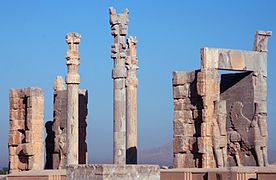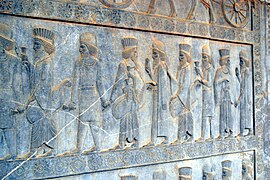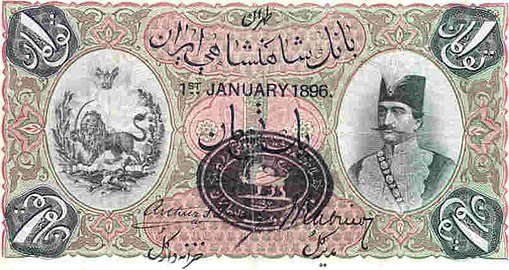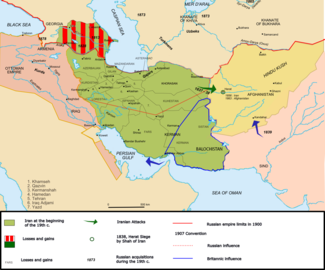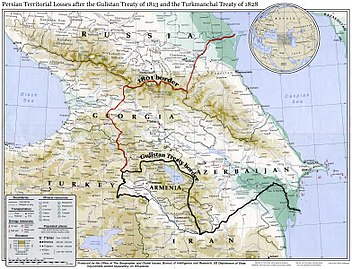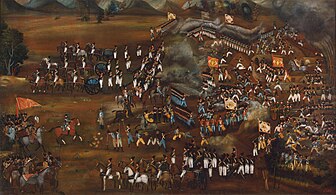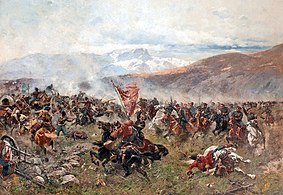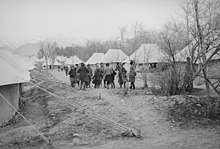History of Iran
| History ofIran |
|---|
 |
|
Timeline |
Thehistory of Iran(orPersia,as it was commonly known in theWestern world) is intertwined with that ofGreater Iran,a sociocultural region spanning the area betweenAnatoliain the west and theIndus RiverandSyr Daryain the east, and between theCaucasusandEurasian Steppein the north and thePersian Gulfand theGulf of Omanin the south. Central to this area is the modern-day country ofIran,which covers the bulk of theIranian plateau.
Iran is home to one of the world's oldest continuous major civilizations, with historical and urban settlements dating back to 4000 BC.[1]The south-western and western part of theIranian plateauparticipated in the traditionalancient Near EastwithElam(3200–539 BC), from theBronze Age,and later with various other peoples, such as theKassites,Mannaeans,andGutians.Georg Wilhelm Friedrich Hegelcalls the Persians the "first Historical People".[2]TheMedesunified Iran as a nation and empire in 625 BC.[3]TheAchaemenid Empire(550–330 BC), founded byCyrus the Great,ruled from theBalkansto North Africa and also Central Asia, spanning three continents, from their seat of power inPersis(Persepolis). It wasthe largest empire yet seen.[4]They were succeeded by theSeleucid,Parthian,andSasanian Empires,who successively governed Iran for almost 1,000 years and made Iran once again a leading power in the world. Persia's arch-rival was theRoman Empireand its successor, theByzantine Empire.
The Iranian Empire proper begins in theIron Age,following the influx ofIranian peoples.Iranian people gave rise to theMedes,the Achaemenid, Parthian, and Sasanian Empires ofclassical antiquity.
Once a major empire, Iran has endured invasions too, by theMacedonians,Arabs,Turks,andMongols.Iran has continually reasserted itsnational identitythroughout the centuries and has developed as a distinct political and cultural entity.
TheMuslim conquest of Persia(632–654) ended the Sasanian Empire, and was a turning point in Iranian history.Islamization of Irantook place during the eighth to tenth centuries, leading to the eventual decline ofZoroastrianismin Iran as well as many of its dependencies. However, the achievements of the previous Persian civilizations were not lost but were to a great extent absorbed by the newIslamicpolity and civilization.
Iran, with its long history of early cultures and empires, had suffered particularly hard during theLate Middle Agesand theearly modern period.Many invasions of nomadic tribes, whose leaders became rulers in this country, affected it negatively.[5]
Iran was reunified as an independent state in 1501 by theSafavid dynasty,whichset Shia Islamas the empire's official religion,[6]marking one of the most important turning points in thehistory of Islam.[7]Functioning again as a leading world power, this time amongst the neighbouringOttoman Empire,its arch-rivalfor centuries,Iran had been a monarchy ruled by an emperor almost without interruption from 1501 until the 1979Iranian Revolution,when Iran officially became anIslamic republicon 1 April 1979.[8][9]
Over the course of the first half of the 19th century, Iran lost many of its territories in theCaucasus,which had been a part of Iran for centuries,[10]comprising modern-dayEastern Georgia,Dagestan,Republic of Azerbaijan,andArmenia,to its rapidly expanding and emerging rival neighbor, theRussian Empire,following the Russo-Persian Wars between1804–1813and1826–1828.[11]
Prehistory
[edit]Paleolithic
[edit]The earliest archaeological artifacts in Iran were found in theKashafrudandGanj Parsites that are thought to date back to 10,000 years ago in the Middle Paleolithic.[12]Mousterianstone tools made byNeanderthalshave also been found.[13]There are more cultural remains of Neanderthals dating back to theMiddle Paleolithicperiod, which mainly have been found in the Zagros region and fewer in central Iran at sites such as Kobeh, Kunji,Bisitun Cave,Tamtama,Warwasi,andYaftehCave.[14]In 1949, a Neanderthalradiuswas discovered byCarleton S. Coonin Bisitun Cave.[15]Evidence forUpper PaleolithicandEpipaleolithicperiods are known mainly from theZagros Mountainsin the caves ofKermanshahandKhorramabadand a few number of sites inPiranshahrandAlborzandCentral Iran.During this time, people began creatingrock art.[citation needed]
Neolithic to Chalcolithic
[edit]Early agricultural communities such asChogha Golanin 10,000 BC[16][17]along with settlements such asChogha Bonut(the earliest village in Elam) in 8000 BC,[18][19]began to flourish in and around the Zagros Mountains region in western Iran.[20]Around about the same time, the earliest-known clay vessels and modelled human and animal terracotta figurines were produced at Ganj Dareh, also in western Iran.[20]There are also 10,000-year-old human and animal figurines from Tepe Sarab in Kermanshah Province among many other ancient artefacts.[21]
The south-western part of Iran was part of theFertile Crescentwhere most of humanity's first major crops were grown, in villages such asSusa(where a settlement was first founded possibly as early as 4395 cal BC)[22]: 46–47 and settlements such asChogha Mish,dating back to 6800 BC;[23][24]there are 7,000-year-old jars of wineexcavatedin the Zagros Mountains[25](now on display at theUniversity of Pennsylvania) and ruins of 7000-year-old settlements such asTepe Sialkare further testament to that. The two main Neolithic Iranian settlements wereGanj Darehand the hypotheticalZayandeh River Culture.[26]
Bronze Age
[edit]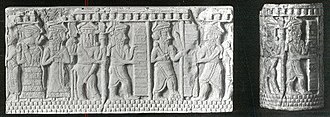

Parts of what is modern-day northwestern Iran was part of theKura–Araxes culture(circa 3400 BC—ca. 2000 BC), that stretched up into the neighbouring regions of theCaucasusandAnatolia.[27][28]
Susais one of the oldest-known settlements of Iran and the world. Based on C14 dating, the time of the foundation of the city is as early as 4395 BC,[22]: 45–46 a time right after the establishment of the ancient Sumerian city of Uruk in 4500 BC. The general perception among archaeologists is that Susa was an extension of theSumeriancity-state ofUruk,hence incorporating many aspects of Mesopotamian culture.[29][30]In its later history, Susa became the capital of Elam, which emerged as a state founded 4000 BC.[22]: 45–46 There are also dozens ofprehistoricsites across the Iranian plateau pointing to the existence of ancient cultures and urban settlements in the fourth millennium BC.[23]One of the earliest civilizations on the Iranian plateau was theJiroft culturein southeastern Iran in the province ofKerman.
It is one of the most artefact-rich archaeological sites in the Middle East. Archaeological excavations in Jiroft led to the discovery of several objects belonging to the 4th millennium BC.[31]There is a large quantity of objects decorated with highly distinctive engravings of animals, mythological figures, and architectural motifs. The objects and their iconography are considered unique. Many are made fromchlorite,a grey-green soft stone; others are incopper,bronze,terracotta,and evenlapis lazuli.Recent excavations at the sites have produced the world's earliest inscription which pre-dates Mesopotamian inscriptions.[32][33]
There are records of numerous other ancient civilizations on theIranian plateaubefore the emergence ofIranian peoplesduring theEarly Iron Age.TheEarly Bronze Agesaw the rise of urbanization into organized city-states and the invention of writing (theUruk period) in the Near East. While Bronze AgeElammade use of writing from an early time, theProto-Elamite scriptremains undeciphered, and records fromSumerpertaining to Elam are scarce.
Russian historianIgor M. Diakonoffstated that the modern inhabitants of Iran are descendants of mainly non-Indo-European groups, more specifically of pre-Iranic inhabitants of the Iranian Plateau: "It is the autochthones of the Iranian plateau, and not the Proto-Indo-European tribes of Europe, which are, in the main, the ancestors, in the physical sense of the word, of the present-day Iranians."[34]
Early Iron Age
[edit]
Records become more tangible with the rise of theNeo-Assyrian Empireand its records of incursions from the Iranian plateau. As early as the 20th century BC, tribes came to the Iranian plateau from thePontic–Caspian steppe.The arrival of Iranians on the Iranian plateau forced theElamitesto relinquish one area of their empire after another and to take refuge in Elam,Khuzestanand the nearby area, which only then became coterminous with Elam.[35]Bahman Firuzmandi say that the southern Iranians might be intermixed with the Elamite peoples living in the plateau.[36] By the mid-first millennium BC,Medes,Persians,andParthianspopulated the Iranian plateau. Until the rise of the Medes, they all remained underAssyriandomination, like the rest of theNear East.In the first half of the first millennium BC, parts of what is nowIranian Azerbaijanwere incorporated intoUrartu.
Classical antiquity
[edit]Median and Achaemenid Empire (680–330 BC)
[edit]-
The tomb ofCyrus the Great
-
Ruins of theGate of All Nations,Persepolis
-
Ruins of theApadana,Persepolis
-
Ruins of theTachara,Persepolis
In 646 BC,AssyriankingAshurbanipalsackedSusa,which ended Elamite supremacy in the region.[37]For over 150 years Assyrian kings of nearby NorthernMesopotamiahad been wanting to conquerMedian tribesof Western Iran.[38]Under pressure from Assyria, the small kingdoms of the western Iranian plateau coalesced into increasingly larger and more centralized states.[37]
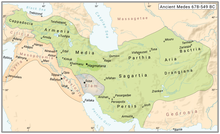
In the second half of the seventh century BC, the Medes gained their independence and were united byDeioces.In 612 BC,Cyaxares,Deioces' grandson, and theBabyloniankingNabopolassarinvaded Assyria and laid siege to and eventually destroyedNineveh,the Assyrian capital, which led to the fall of theNeo-Assyrian Empire.[39]Urartuwas later on conquered and dissolved as well by the Medes.[40][41]The Medes are credited with founding Iran as a nation and empire, and established the first Iranian empire, the largest of its day untilCyrus the Greatestablished a unified empire of the Medes and Persians, leading to theAchaemenid Empire(c.550–330 BC).
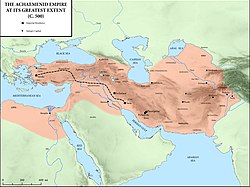
Cyrus the Greatoverthrew, in turn, the Median,Lydian,andNeo-Babylonian Empires,creating an empire far larger than Assyria. He was better able, through more benign policies, to reconcile his subjects to Persian rule; the longevity of his empire was one result. The Persian king, like theAssyrian,was also "King of Kings",xšāyaθiya xšāyaθiyānām(shāhanshāhin modern Persian) – "great king",Megas Basileus,as known by theGreeks.
Cyrus's son,Cambyses II,conquered the last major power of the region,ancient Egypt,causing the collapse of theTwenty-sixth Dynasty of Egypt.Since he became ill and died before, or while, leavingEgypt,stories developed, as related byHerodotus,that he was struck down for impiety against theancient Egyptian deities.After the death of Cambyses II, Darius ascended the throne by overthrowing the legitimate Achaemenid monarchBardiya,and then quelling rebellions throughout his kingdom. As the winner,Darius I,based his claim on membership in a collateral line of the Achaemenid Empire.
Darius' first capital was at Susa, and he started the building program atPersepolis.He rebuilt a canal between theNileand theRed Sea,a forerunner of the modernSuez Canal.He improved the extensive road system, and it is during his reign that mentions are first made of theRoyal Road(shown on map), a great highway stretching all the way from Susa toSardiswith posting stations at regular intervals. Major reforms took place under Darius.Coinage,in the form of thedaric(gold coin) and theshekel(silver coin) was standardized (coinage had already been invented over a century before in Lydia c. 660 BC but not standardized),[42]and administrative efficiency increased.
TheOld Persianlanguage appears in royal inscriptions, written in a specially adapted version of thecuneiform script.Under Cyrus the Great andDarius I,the Persian Empire eventually became the largest empire in human history up until that point, ruling and administrating over most of the then known world,[43]as well as spanning the continents ofEurope,Asia, and Africa. The greatest achievement was the empire itself. The Persian Empire represented the world's firstsuperpower[44][45]that was based on a model of tolerance and respect for other cultures and religions.[46]

In the late sixth century BC, Darius launched his European campaign, in which he defeated thePaeonians,conqueredThrace,and subdued all coastal Greek cities,as well as defeatingthe EuropeanScythiansaround theDanuberiver.[47]In 512/511 BC,Macedonbecame avassalkingdom of Persia.[47]
In 499 BC,Athenslent support to a revolt inMiletus,which resulted in the sacking ofSardis.This led to an Achaemenid campaign against mainland Greece known as theGreco-Persian Wars,which lasted the first half of the 5th century BC, and is known as one of the most important wars inEuropean history.In theFirst Persian invasion of Greece,the Persian generalMardoniusre-subjugated Thrace and made Macedon a full part of Persia.[47]The war eventually turned out in defeat, however. Darius' successorXerxes Ilaunched theSecond Persian invasion of Greece.At a crucial moment in the war, about half of mainland Greece was overrun by the Persians, including all territories to the north of the Isthmus ofCorinth,[48][49]however, this was also turned out in a Greek victory, following the battles ofPlataeaandSalamis,by which Persia lost its footholds in Europe, and eventually withdrew from it.[50]During the Greco-Persian wars, the Persians gained major territorial advantages. Theycaptured and razed Athens twice,once in 480 BC and again in 479 BC. However, after a string of Greek victories the Persians were forced to withdraw, thus losing control ofMacedonia,ThraceandIonia.Fighting continued for several decades after the successful Greek repelling of the Second Invasion with numerous Greek city-states under the Athens' newly formedDelian League,which eventually ended with the peace of Callias in 449 BC, ending the Greco-Persian Wars. In 404 BC, following the death ofDarius II,Egypt rebelled underAmyrtaeus.Laterpharaohssuccessfully resisted Persian attempts to reconquer Egypt until 343 BC, when Egypt was reconquered byArtaxerxes III.

Greek conquest and Seleucid Empire (312 BC–248 BC)
[edit]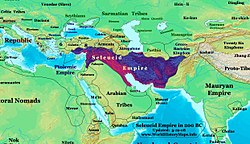
From 334 BC to 331 BC,Alexander the GreatdefeatedDarius IIIin the battles ofGranicus,IssusandGaugamela,swiftly conquering the Persian Empire by 331 BC. Alexander's empire broke up shortly after his death, and Alexander's general,Seleucus I Nicator,tried to take control of Iran,Mesopotamia,and laterSyriaandAnatolia.His empire was theSeleucid Empire.He was killed in 281 BC byPtolemy Keraunos.
Greek language, philosophy, and art came with the colonists. During the Seleucid era, Greek became the common tongue of diplomacy and literature throughout the empire.
Parthian Empire (248 BC–224 AD)
[edit]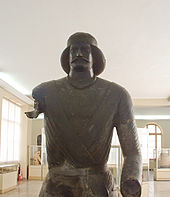

TheParthian Empire—ruled by the Parthians, a group of northwestern Iranian people—was the realm of the Arsacid dynasty. This latter reunited and governed the Iranian plateau after theParni conquest of Parthiaand defeating the Seleucid Empire in the late third century BC. It intermittently controlled Mesopotamia betweenc. 150 BC and 224 ADand absorbedEastern Arabia.
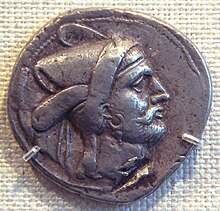
Parthia was the eastern arch-enemy of theRoman Empireand it limited Rome's expansion beyondCappadocia(central Anatolia). The Parthian armies included two types ofcavalry:the heavily armed and armoredcataphractsand the lightly armed but highly-mobilemounted archers.
For the Romans, who relied on heavyinfantry,the Parthians were too hard to defeat, as both types of cavalry were much faster and more mobile than foot soldiers. TheParthian shotused by the Parthian cavalry was most notably feared by the Roman soldiers, which proved pivotal in the crushing Roman defeat at theBattle of Carrhae.On the other hand, the Parthians found it difficult to occupy conquered areas as they were unskilled insiegewarfare. Because of these weaknesses, neither the Romans nor the Parthians were able completely toannexeach other's territory.
The Parthian empire subsisted for five centuries, longer than most Eastern Empires. The end of this empire came at last in 224 AD, when the empire's organization had loosened and the last king was defeated by one of the empire's vassal peoples, the Persians under the Sasanians. However, the Arsacid dynasty continued to exist for centuries onwards inArmenia,theIberia,and theCaucasian Albania,which were all eponymous branches of the dynasty.
Sasanian Empire (224–651 AD)
[edit]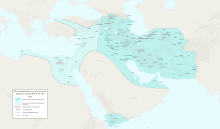

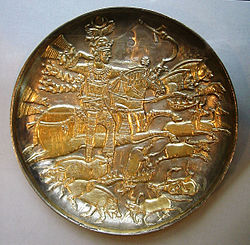
The first shah of the Sasanian Empire,Ardashir I,started reforming the country economically and militarily. For a period of more than 400 years, Iran was once again one of the leading powers in the world, alongside its neighbouring rival, theRomanand thenByzantine Empires.[51][52]The empire's territory, at its height, encompassed all of today'sIran,Iraq,Azerbaijan,Armenia,Georgia,Abkhazia,Dagestan,Lebanon,Jordan,Palestine,Israel,parts ofAfghanistan,Turkey,Syria,parts ofPakistan,Central Asia,Eastern Arabia,and parts ofEgypt.
Most of the Sasanian Empire's lifespan was overshadowed by the frequentByzantine–Sasanian wars,a continuation of theRoman–Parthian Warsand the all-comprisingRoman–Persian Wars;the last was the longest-lasting conflict in human history. Started in the first century BC by their predecessors, the Parthians, and Romans, the last Roman–Persian War was fought in the seventh century. The Persians defeated the Romans at theBattle of Edessain 260 and took emperorValerianprisoner for the remainder of his life.
Eastern Arabia was conquered early on. DuringKhosrow II's rule in 590–628,Egypt,Jordan,PalestineandLebanonwere also annexed to the Empire. The Sassanians called their empireErânshahr( "Dominion of the Aryans", i.e., ofIranians).[53]
A chapter of Iran's history followed after roughly six hundred years of conflict with the Roman Empire. During this time, the Sassanian and Romano-Byzantine armies clashed for influence in Anatolia, the western Caucasus (mainlyLazicaand theKingdom of Iberia;modern-dayGeorgiaandAbkhazia),Mesopotamia,Armenia and the Levant. Under Justinian I, the war came to an uneasy peace with payment of tribute to the Sassanians.
However, the Sasanians used the deposition of the Byzantine emperorMauriceas acasus bellito attack the Empire. After many gains, the Sassanians were defeated at Issus, Constantinople, and finally Nineveh, resulting in peace. With the conclusion of the over 700 years lasting Roman–Persian Wars through the climacticByzantine–Sasanian War of 602–628,which included the verysiege of the Byzantine capital of Constantinople,the war-exhausted Persians lost theBattle of al-Qādisiyyah(632) inHilla(present-dayIraq) to the invading Muslim forces.
The Sasanian era, encompassing the length ofLate Antiquity,is considered to be one of the most important and influential historical periods in Iran, and had a major impact on the world. In many ways, the Sassanian period witnessed the highest achievement of Persian civilization and constitutes the last great Iranian Empire before the adoption of Islam. Persia influenced Roman civilization considerably during Sassanian times,[54]their cultural influence extending far beyond the empire's territorial borders, reaching as far as Western Europe,[55]Africa,[56]China and India[57]and also playing a prominent role in the formation of both European and Asiatic medieval art.[58]
This influence carried forward to theMuslim world.The dynasty's unique and aristocratic culture transformed the Islamic conquest and destruction of Iran into a Persian Renaissance.[55]Much of what later became known as Islamic culture, architecture, writing, and other contributions to civilization, were taken from the Sassanian Persians into the broader Muslim world.[59]

Medieval period
[edit]Early Islamic period
[edit]Islamic conquest of Persia (633–651)
[edit]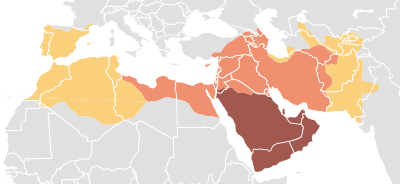
In 633, when the Sasanian kingYazdegerd IIIwas ruling over Iran, the Muslims underUmarinvaded the country right after it had been in a bloody civil war. Several Iranian nobles and families such as king Dinar of theHouse of Karen,and laterKanarangiyansofKhorasan,mutinied against their Sasanian overlords. Although theHouse of Mihranhad claimed the Sasanian throne under the two prominent generalsBahrām ChōbinandShahrbaraz,it remained loyal to the Sasanians during their struggle against the Arabs, but the Mihrans were eventually betrayed and defeated by their own kinsmen, theHouse of Ispahbudhan,under their leaderFarrukhzad,who had mutinied against Yazdegerd III.
Yazdegerd III fled from one district to another until a local miller killed him for his purse atMervin 651.[60]By 674, Muslims had conqueredGreater Khorasan(which included modern Iranian Khorasan province and modern Afghanistan and parts ofTransoxiana).
TheMuslim conquest of Persiaended the Sasanian Empire and led to the eventual decline of theZoroastrianreligion in Persia. Over time, the majority of Iranians converted to Islam. Most of the aspects of the previous Persian civilizations were not discarded but were absorbed by the newIslamicpolity. AsBernard Lewishas commented:
"These events have been variously seen in Iran: by some as a blessing, the advent of the true faith, the end of the age of ignorance and heathenism; by others as a humiliating national defeat, the conquest and subjugation of the country by foreign invaders. Both perceptions are of course valid, depending on one's angle of vision."[61]
Umayyad era and Muslim incursions into the Caspian coast
[edit]After the fall of the Sasanian Empire in 651, theArabsof theUmayyad Caliphateadopted many Persian customs, especially the administrative and the court mannerisms. Arab provincial governors were undoubtedly either PersianizedArameansor ethnic Persians; certainly Persian remained the language of official business of the caliphate until the adoption of Arabic toward the end of the seventh century,[62]when in 692 minting began at the capital,Damascus.The new Islamic coins evolved from imitations of Sasanian coins (as well asByzantine), and thePahlavi scripton the coinage was replaced withArabic alphabet.
During the Umayyad Caliphate, the Arab conquerors imposedArabicas the primary language of the subject peoples throughout their empire.Al-Hajjaj ibn Yusuf,who was not happy with the prevalence of the Persian language in thedivan,ordered the official language of the conquered lands to be replaced by Arabic, sometimes by force.[63]Inal-Biruni'sFrom The Remaining Signs of Past Centuriesfor example it is written:
"WhenQutaibah bin Muslimunder the command of Al-Hajjaj bin Yousef was sent toKhwarazmiawith a military expedition and conquered it for the second time, he swiftly killed whoever wrote the Khwarazmian native language that knew of the Khwarazmian heritage, history, and culture. He then killed all their Zoroastrian priests and burned and wasted their books, until gradually the illiterate only remained, who knew nothing of writing, and hence their history was mostly forgotten. "[64]
There are a number of historians who see the rule of the Umayyads as setting up the "dhimmah" to increase taxes from thedhimmisto benefit the Muslim Arab community financially and by discouraging conversion.[65]Governors lodged complaints with the caliph when he enacted laws that made conversion easier, depriving the provinces of revenues.
In the 7th century, when many non-Arabs such asPersiansentered Islam, they were recognized asmawali( "clients" ) and treated as second-class citizens by the ruling Arab elite until the end of the Umayyad Caliphate. During this era, Islam was initially associated with the ethnic identity of the Arab and required formal association with anArab tribeand the adoption of the client status ofmawali.[65]The half-hearted policies of the late Umayyads to tolerate non-Arab Muslims and Shias had failed to quell unrest among these minorities.
However, all of Iran was still not under Arab control, and the region ofDaylamwas under the control of theDaylamites,whileTabaristanwas underDabuyidandPaduspanidcontrol, and theMount Damavandregion underMasmughans of Damavand.The Arabs had invaded these regions several times but achieved no decisive result because of the inaccessible terrain of the regions. The most prominent ruler of the Dabuyids, known asFarrukhan the Great(r. 712–728), managed to hold his domains during his long struggle against the Arab generalYazid ibn al-Muhallab,who was defeated by a combined Dailamite-Dabuyid army, and was forced to retreat from Tabaristan.[66]
With the death of the Umayyad CaliphHisham ibn Abd al-Malikin 743, the Islamic world was launched into civil war.Abu Muslimwas sent to Khorasan by theAbbasid Caliphateinitially as a propagandist and then to revolt on their behalf. He tookMervdefeating the Umayyad governor thereNasr ibn Sayyar.He became thede factoAbbasid governor of Khurasan. During the same period, the Dabuyid rulerKhurshiddeclared independence from the Umayyads but was shortly forced to recognize Abbasid authority. In 750, Abu Muslim became the leader of the Abbasid army and defeated the Umayyads at theBattle of the Zab.Abu Muslim stormedDamascus,the capital of the Umayyad caliphate, later that year.
Abbasid period and autonomous Iranian dynasties
[edit]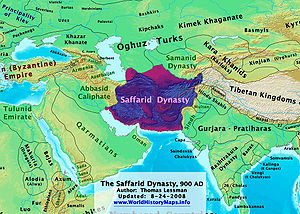
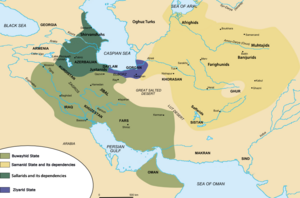
The Abbasid army consisted primarily of Khorasanians and was led by an Iranian general,Abu Muslim Khorasani.It contained both Iranian and Arab elements, and the Abbasids enjoyed both Iranian and Arab support. The Abbasids overthrew the Umayyads in 750.[67]According to Amir Arjomand, theAbbasid Revolutionessentially marked the end of the Arab empire and the beginning of a more inclusive, multi-ethnic state in the Middle East.[68]
One of the first changes the Abbasids made after taking power from the Umayyads was to move the empire's capital fromDamascus,in theLevant,toIraq.The latter region was influenced by Persian history and culture, and moving the capital was part of the Persian mawali demand for Arab influence in the empire. The city ofBaghdadwas constructed on theTigris River,in 762, to serve as the new Abbasid capital.[69]
The Abbasids established the position ofvizierlikeBarmakidsin their administration, which was the equivalent of a "vice-caliph", or second-in-command. Eventually, this change meant that many caliphs under the Abbasids ended up in a much more ceremonial role than ever before, with the vizier in real power. A new Persian bureaucracy began to replace the old Arab aristocracy, and the entire administration reflected these changes, demonstrating that the new dynasty was different in many ways from the Umayyads.[69]
By the 9th century, Abbasid control began to wane as regional leaders sprang up in the far corners of the empire to challenge the central authority of the Abbasid caliphate.[69]The Abbasid caliphs began enlistingmamluks,Turkic-speaking warriors, who had been moving out of Central Asia intoTransoxianaas slave warriors as early as the 9th century. Shortly thereafter the real power of the Abbasid caliphs began to wane; eventually, they became religious figureheads while the warrior slaves ruled.[67]

The 9th century also saw the revolt by native Zoroastrians, known as theKhurramites,against oppressive Arab rule. The movement was led by a Persian freedom fighterBabak Khorramdin.Babak's Iranianizing[70]rebellion, from its base inAzerbaijaninnorthwestern Iran,[71]called for a return of the political glories of theIranian[72]past. The Khorramdin rebellion of Babak spread to the Western and Central parts ofIranand lasted more than twenty years before it was defeated when Babak was betrayed byAfshin,a senior general of the Abbasid Caliphate.
As the power of the Abbasid caliphs diminished, a series of dynasties rose in various parts of Iran, some with considerable influence and power. Among the most important of these overlapping dynasties were theTahiridsinKhorasan(821–873); theSaffaridsinSistan(861–1003, their rule lasted as maliks of Sistan until 1537); and theSamanids(819–1005), originally atBukhara.The Samanids eventually ruled an area from central Iran to Pakistan.[67]
By the early 10th century, the Abbasids almost lost control to the growing Persian faction known as theBuyid dynasty(934–1062). Since much of the Abbasid administration had been Persian anyway, the Buyids were quietly able to assume real power in Baghdad. The Buyids were defeated in the mid-11th century by theSeljuqTurks, who continued to exert influence over the Abbasids, while publicly pledging allegiance to them. The balance of power in Baghdad remained as such – with the Abbasids in power in name only – until the Mongol invasion of 1258 sacked the city and definitively ended the Abbasid dynasty.[69]
During theAbbasidperiod an enfranchisement was experienced by themawaliand a shift was made in political conception from that of a primarily Arab empire to one of a Muslim empire[73]and c. 930 a requirement was enacted that required all bureaucrats of the empire be Muslim.[65]
Islamic golden age, Shu'ubiyya movement and Persianization process
[edit]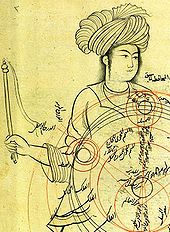
Islamizationwas a long process by whichIslamwas gradually adopted by the majority population of Iran.Richard Bulliet's "conversion curve" indicates that only about 10% of Iran converted to Islam during the relatively Arab-centricUmayyadperiod. Beginning in theAbbasidperiod, with its mix of Persian as well as Arab rulers, the Muslim percentage of the population rose. As Persian Muslims consolidated their rule of the country, the Muslim population rose from approximately 40% in the mid-9th century to close to 90% by the end of the 11th century.[73]Seyyed Hossein Nasrsuggests that the rapid increase in conversion was aided by the Persian nationality of the rulers.[74]
Although Persians adopted the religion of their conquerors, over the centuries they worked to protect and revive their distinctive language and culture, a process known asPersianization.Arabs and Turks participated in this attempt.[75][76][77]
In the 9th and 10th centuries, non-Arab subjects of theUmmahcreated a movement calledShu'ubiyyahin response to the privileged status of Arabs. Most of those behind the movement were Persian, but references toEgyptians,BerbersandAramaeansare attested.[78]Citing as its basis Islamic notions of equality of races and nations, the movement was primarily concerned with preservingPersianculture and protecting Persian identity, though within a Muslim context.
TheSamanid dynastyled the revival of Persian culture and the first important Persian poet after the arrival of Islam,Rudaki,was born during this era and was praised by Samanid kings. The Samanids also revived many ancient Persian festivals. Their successor, theGhaznawids,who were of non-Iranian Turkic origin, also became instrumental in the revival of Persian culture.[79]
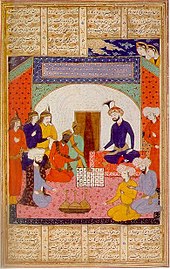
The culmination of thePersianizationmovement was theShahnameh,the national epic of Iran, written almost entirely in Persian. This voluminous work, reflects Iran's ancient history, its unique cultural values, its pre-IslamicZoroastrianreligion, and its sense of nationhood. According toBernard Lewis:[61]
"Iran was indeed Islamized, but it was not Arabized. Persians remained Persians. And after an interval of silence, Iran re-emerged as a separate, different and distinctive element within Islam, eventually adding a new element even to Islam itself. Culturally, politically, and most remarkable of all even religiously, the Iranian contribution to this new Islamic civilization is of immense importance. The work of Iranians can be seen in every field of cultural endeavour, including Arabic poetry, to which poets of Iranian origin composing their poems in Arabic made a very significant contribution. In a sense, Iranian Islam is a second advent of Islam itself, a new Islam sometimes referred to as Islam-i Ajam. It was this Persian Islam, rather than the original Arab Islam, that was brought to new areas and new peoples: to the Turks, first in Central Asia and then in the Middle East in the country which came to be called Turkey, and of course to India. The Ottoman Turks brought a form of Iranian civilization to the walls of Vienna..."
TheIslamization of Iranwas to yield deep transformations within the cultural, scientific, and political structure of Iran's society: The blossoming ofPersian literature,philosophy,medicineandartbecame major elements of the newly forming Muslim civilization. Inheriting a heritage of thousands of years of civilization, and being at the "crossroads of the major cultural highways",[82]contributed to Persia emerging as what culminated into the "Islamic Golden Age".During this period,hundreds of scholars and scientistsvastly contributed to technology, science and medicine, later influencing the rise of European science duringthe Renaissance.[83]
The most important scholars of almost all of the Islamic sects and schools of thought were Persian or lived in Iran, including the most notable and reliableHadithcollectors ofShiaandSunnilikeShaikh Saduq,Shaikh Kulainy,Hakim al-Nishaburi,Imam Muslimand Imam Bukhari, the greatesttheologiansof Shia and Sunni likeShaykh Tusi,Imam Ghazali,Imam Fakhr al-RaziandAl-Zamakhshari,the greatestphysicians,astronomers,logicians,mathematicians,metaphysicians,philosophersandscientistslikeAvicennaandNasīr al-Dīn al-Tūsī,and the greatestshaykhs of SufismlikeRumiandAbdul-Qadir Gilani.
Persianate states and dynasties (977–1219)
[edit]
In 977, a Turkic governor of the Samanids,Sabuktigin,conqueredGhazna(in present-day Afghanistan) and established a dynasty, theGhaznavids,that lasted to 1186.[67]The Ghaznavid empire grew by taking all of the Samanid territories south of theAmu Daryain the last decade of the 10th century, and eventually occupied parts of Eastern Iran, Afghanistan, Pakistan and north-west India.[69]
The Ghaznavids are generally credited with launching Islam into a mainlyHinduIndia. The invasion of India was undertaken in 1000 by the Ghaznavid ruler,Mahmud,and continued for several years. They were unable to hold power for long, however, particularly after the death of Mahmud in 1030. By 1040 the Seljuqs had taken over the Ghaznavid lands in Iran.[69]
TheSeljuqs,who like the Ghaznavids were Persianate in nature and of Turkic origin, slowly conquered Iran over the course of the 11th century.[67]The dynasty had its origins in theTurcomantribal confederations of Central Asia and marked the beginning ofTurkicpower in the Middle East. They established aSunni Muslimrule over parts ofCentral Asiaand the Middle East from the 11th to 14th centuries. They set up an empire known as Great Seljuq Empire that stretched from Anatolia in the west to western Afghanistan in the east and the western borders of (modern-day)Chinain the north-east; and was the target of theFirst Crusade.Today they are regarded as the cultural ancestors of the WesternTurks,the present-day inhabitants ofTurkey,AzerbaijanandTurkmenistan,and they are remembered as great patrons ofPersian culture,art,literature,andlanguage.[84][85][86]

The founder of the dynasty,Tughril Beg,turned his army against the Ghaznavids in Khorasan. He moved south and then west, conquering but not wasting the cities in his path. In 1055 the caliph in Baghdad gave Tughril Beg robes, gifts, and the title King of the East. Under Tughril Beg's successor,Malik Shah(1072–1092), Iran enjoyed a cultural and scientific renaissance, largely attributed to his brilliant Iranian vizier,Nizam al Mulk.These leaders established the observatory whereOmar Khayyámdid much of his experimentation for a new calendar, and they builtreligious schoolsin all the major towns. They broughtAbu Hamid Ghazali,one of the greatest Islamic theologians, and other eminent scholars to the Seljuq capital at Baghdad and encouraged and supported their work.[67]
When Malik Shah I died in 1092, the empire split as his brother and four sons quarreled over the apportioning of the empire among themselves. In Anatolia, Malik Shah I was succeeded byKilij Arslan Iwho founded theSultanate of Rûmand in Syria by his brotherTutush I.InPersiahe was succeeded by his sonMahmud Iwhose reign was contested by his other three brothersBarkiyaruqinIraq,Muhammad IinBaghdadandAhmad SanjarinKhorasan.As Seljuq power in Iran weakened, other dynasties began to step up in its place, including a resurgent Abbasid caliphate and theKhwarezmshahs.The Khwarezmid Empire was a Sunni Muslim Persianate dynasty, of East Turkic origin, that ruled in Central Asia. Originally vassals of the Seljuqs, they took advantage of the decline of the Seljuqs to expand into Iran.[87]In 1194 the KhwarezmshahAla ad-Din Tekishdefeated the Seljuq sultanToghrul IIIin battle and the Seljuq empire in Iran collapsed. Of the former Seljuq Empire, only theSultanate of Rumin Anatolia remained.
A serious internal threat to the Seljuqs during their reign came from theNizari Ismailis,a secret sect with headquarters atAlamut CastlebetweenRashtandTehran.They controlled the immediate area for more than 150 years and sporadically sent out adherents to strengthen their rule by murdering important officials. Several of the various theories on the etymology of the wordassassinderive from these killers.[67]
Parts of northwestern Iran were conquered in the early 13th century AD by theKingdom of Georgia,led byTamar the Great.[88]
Mongol conquest and rule (1219–1370)
[edit]Mongol invasion (1219–1221)
[edit]

TheKhwarazmian dynastyonly lasted for a few decades, until the arrival of theMongols.Genghis Khanhad unified the Mongols, and under him theMongol Empirequickly expanded in several directions. In 1218, it bordered Khwarezm. At that time, the Khwarazmian Empire was ruled byAla ad-Din Muhammad(1200–1220). Muhammad, like Genghis, was intent on expanding his lands and had gained the submission of most of Iran. He declared himself shah and demanded formal recognition from the Abbasid caliphAl-Nasir.When the caliph rejected his claim, Ala ad-Din Muhammad proclaimed one of his nobles caliph and unsuccessfully tried to depose an-Nasir.
TheMongol invasion of Iranbegan in 1219, after two diplomatic missions to Khwarezm sent by Genghis Khan had been massacred. During 1220–21Bukhara,Samarkand,Herat,TusandNishapurwere razed, and the whole populations were slaughtered. The Khwarezm-Shah fled, to die on an island off the Caspian coast.[89] During the invasion ofTransoxianain 1219, along with the main Mongol force, Genghis Khan used a Chinese specialist catapult unit in battle, they were used again in 1220 in Transoxania. The Chinese may have used the catapults to hurl gunpowder bombs, since they already had them by this time.[90]
While Genghis Khan was conquering Transoxania and Persia, several Chinese who were familiar with gunpowder were serving in Genghis's army.[91]"Whole regiments" entirely made out of Chinese were used by the Mongols to command bomb hurling trebuchets during the invasion of Iran.[92]Historians have suggested that the Mongol invasion had brought Chinese gunpowder weapons to Central Asia. One of these was thehuochong,a Chinese mortar.[93]Books written around the area afterward depicted gunpowder weapons which resembled those of China.[94]
Destruction under the Mongols
[edit]Before his death in 1227, Genghis had reached western Azerbaijan, pillaging and burning many cities along the way after entering into Iran from its north east.
The Mongol invasion was by and large disastrous to the Iranians. Although the Mongol invaders eventually converted to Islam and accepted the culture of Iran, the Mongol destruction in Iran and other regions of the Islamic heartland (particularly the historical Khorasan region, mainly in Central Asia) marked a major change of direction for the region. Much of the six centuries of Islamic scholarship, culture, and infrastructure was destroyed as the invaders leveled cities, burned libraries, and in some cases replaced mosques withBuddhist temples.[95][96][97]
The Mongols killed many Iranian civilians. Destruction ofqanatirrigation systems in the north east of Iran destroyed the pattern of relatively continuous settlements, producing many abandoned towns which were relatively quite good with irrigation and agriculture.[98]
Ilkhanate (1256–1335)
[edit]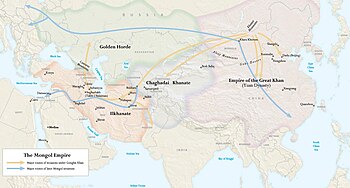
After Genghis's death, Iran was ruled by several Mongol commanders. Genghis' grandson,Hulagu Khan,was tasked with the westward expansion of Mongol dominion. However, by the time he ascended to power, the Mongol Empire had already dissolved, dividing into different factions. Arriving with an army, he established himself in the region and founded theIlkhanate,a breakaway state of the Mongol Empire, which would rule Iran for the next eighty years and become Persian in the process.
Hulagu Khan seized Baghdad in 1258 and put the last Abbasid caliph to death. The westward advance of his forces was stopped by theMamelukes,however, at theBattle of Ain JalutinPalestinein 1260. Hulagu's campaigns against the Muslims also enragedBerke,khan of theGolden Hordeand a convert to Islam. Hulagu and Berke fought against each other, demonstrating the weakening unity of the Mongol empire.
The rule of Hulagu's great-grandson,Ghazan(1295–1304) saw the establishment of Islam as the state religion of the Ilkhanate. Ghazan and his famous Iranian vizier,Rashid al-Din,brought Iran a partial and brief economic revival. The Mongols lowered taxes for artisans, encouraged agriculture, rebuilt and extended irrigation works, and improved the safety of the trade routes. As a result, commerce increased dramatically.
Items from India, China, and Iran passed easily across the Asian steppes, and these contacts culturally enriched Iran. For example, Iranians developed a new style of painting based on a unique fusion of solid, two-dimensional Mesopotamian painting with the feathery, light brush strokes and other motifs characteristic of China. After Ghazan's nephewAbu Saiddied in 1335, however, the Ilkhanate lapsed into civil war and was divided between several petty dynasties – most prominently theJalayirids,Muzaffarids,SarbadarsandKartids.
The mid-14th-centuryBlack Deathkilled about 30% of the country's population.[99]
Sunnism and Shiism in pre-Safavid Iran
[edit]
Prior to the rise of the Safavid Empire, Sunni Islam was the dominant religion, accounting for around 90% of the population at the time. According toMortaza Motahharithe majority of Iranian scholars and masses remained Sunni until the time of the Safavids.[100]The domination of Sunnis did not mean Shia were rootless in Iran. The writers ofThe Four Booksof Shia were Iranian, as well as many other great Shia scholars.
The domination of the Sunni creed during the first nine Islamic centuries characterized the religious history of Iran during this period. There were however some exceptions to this general domination which emerged in the form of theZaydīsofTabaristan(seeAlid dynasties of northern Iran), theBuyids,theKakuyids,the rule ofSultan Muhammad Khudabandah(r. Shawwal 703-Shawwal 716/1304–1316) and theSarbedaran.[101]
Apart from this domination there existed, firstly, throughout these nine centuries, Shia inclinations among many Sunnis of this land and, secondly, originalImami Shiismas well asZaydī Shiismhad prevalence in some parts of Iran. During this period, Shia in Iran were nourished fromKufah,Baghdadand later fromNajafandHillah.[101]Shiism was the dominant sect inTabaristan,Qom,Kashan,AvajandSabzevar.In many other areas merged population of Shia and Sunni lived together.[citation needed]
During the 10th and 11th centuries,FatimidssentIsmailisDa'i (missioners)to Iran as well as other Muslim lands. When Ismailis divided into two sects,Nizarisestablished their base in Iran.Hassan-i Sabbahconquered fortresses and capturedAlamutin 1090 AD. Nizaris used this fortress until a Mongol raid in 1256.[citation needed]
After the Mongol raid and fall of the Abbasids, Sunni hierarchies faltered. Not only did they lose the caliphate but also the status of officialmadhhab.Their loss was the gain of Shia, whose centre wasn't in Iran at that time. Several local Shia dynasties likeSarbadarswere established during this time.[citation needed]
The main change occurred in the beginning of the 16th century, whenIsmail Ifounded theSafavid dynastyand initiated a religious policy torecognize Shi'a Islam as the official religionof theSafavid Empire,and the fact that modern Iran remains an officially Shi'ite state is a direct result of Ismail's actions.[citation needed]
Timurid Empire (1370–1507)
[edit]
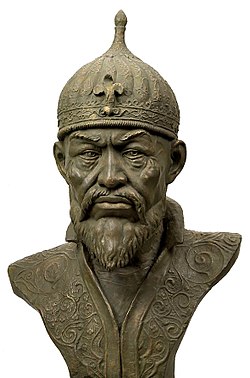
Iran remained divided until the arrival ofTimur,aTurco-Mongol[102]belonging to theTimurid dynasty.Like its predecessors, theTimurid Empirewas also part of the Persianate world. After establishing a power base in Transoxiana, Timur invaded Iran in 1381 and eventually conquered most of it. Timur's campaigns were known for their brutality; many people were slaughtered and several cities were destroyed.[103]
His regime was characterized by tyranny and bloodshed, but also by its inclusion of Iranians in administrative roles and its promotion of architecture and poetry. His successors, the Timurids, maintained a hold on most of Iran until 1452, when they lost the bulk of it toBlack Sheep Turkmen.The Black Sheep Turkmen were conquered by theWhite Sheep TurkmenunderUzun Hasanin 1468; Uzun Hasan and his successors were the masters of Iran until the rise of the Safavids.[103]
SufipoetHafez's popularity became firmly established in the Timurid era that saw the compilation and widespread copying of hisdivan.Sufis were often persecuted by orthodox Muslims who considered their teachingsblasphemous.Sufism developed a symbolic language rich with metaphors to obscure poetic references to provocative philosophical teachings. Hafez concealed his own Sufi faith, even as he employed the secret language of Sufism (developed over hundreds of years) in his own work, and he is sometimes credited with having "brought it to perfection".[104]His work was imitated byJami,whose own popularity grew to spread across the full breadth of the Persianate world.[105]
Kara Koyunlu
[edit]The Kara Koyunlu were aTurkmen[106]tribal federation that ruled over northwesternIranand surrounding areas from 1374 to 1468 CE. The Kara Koyunlu expanded their conquest to Baghdad, however, internal fighting, defeats by theTimurids,rebellions by theArmeniansin response to their persecution,[107]and failed struggles with theAg Qoyunluled to their eventual demise.[108]
Ak Koyunlu
[edit]
Aq Qoyunlu were Turkmen[109][110]under the leadership of theBayandurtribe,[111]tribal federation of Sunni Muslims who ruled over most of Iran and large parts of surrounding areas from 1378 to 1501 CE. Aq Qoyunlu emerged whenTimurgranted them all ofDiyar Bakrin present-day Turkey. Afterward, they struggled with their rival Oghuz Turks, theQara Qoyunlu.While the Aq Qoyunlu were successful in defeating Kara Koyunlu, their struggle with the emergingSafavid dynastyled to their downfall.[112]
Early modern period
[edit]Persia underwent a revival under theSafavid dynasty(1502–1736), the most prominent figure of which wasShah Abbas I.Some historians credit the Safavid dynasty for founding the modern nation-state of Iran. Iran's contemporary Shia character, and significant segments of Iran's current borders take their origin from this era (e.g.Treaty of Zuhab).
Safavid Empire (1501–1736)
[edit]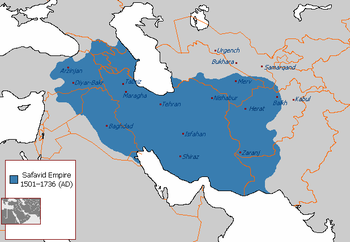
TheSafavid dynastywas one of the most significant ruling dynasties ofPersia(modern Iran), and "is often considered the beginning of modern Persian history".[113]They ruled one of the greatest Persian empires after theMuslim conquest of Persia[114]and established theTwelverschool ofShi'a Islam[6]as theofficial religionof their empire, marking one of the most important turning points inMuslim history.The Safavids ruled from 1501 to 1722 (experiencing a brief restoration from 1729 to 1736) and at their height, they controlled all of modernIran,AzerbaijanandArmenia,most ofGeorgia,theNorth Caucasus,Iraq,KuwaitandAfghanistan,as well as parts ofTurkey,Syria,Pakistan,TurkmenistanandUzbekistan.Safavid Iran was one of the Islamic "gunpowder empires",along with its neighbours, its archrival and principal enemy theOttoman Empire,as well as theMughal Empire.
The Safavid ruling dynasty was founded by Ismāil, who styled himselfShāh Ismāil I.[115]Practically worshipped by hisQizilbāshfollowers, Ismāil invadedShirvanto avenge the death of his father,Shaykh Haydar,who had been killed during his siege ofDerbent,in Dagestan. Afterwards he went on a campaign of conquest, and following the capture ofTabrizin July 1501, he enthroned himself as the Shāh of Iran,[116]: 324 [117][118]minted coins in this name, and proclaimed Shi'ism the official religion of his domain.[6]
Although initially the masters of Azerbaijan and southern Dagestan only, the Safavids had, in fact, won the struggle for power in Persia which had been going on for nearly a century between various dynasties and political forces following the fragmentation of theKara Koyunluand theAq Qoyunlu.A year after his victory in Tabriz, Ismāil proclaimed most of Persia as his domain, and[6]quickly conquered and unified Iran under his rule. Soon afterwards, the new Safavid Empire rapidly conquered regions, nations, and peoples in all directions, includingArmenia,Azerbaijan,parts ofGeorgia,Mesopotamia(Iraq),Kuwait,Syria,Dagestan,large parts of what is nowAfghanistan,parts ofTurkmenistan,and large chunks of Anatolia, laying the foundation of its multi-ethnic character which would heavily influence the empire itself (most notably the Caucasus andits peoples).

Tahmasp I,the son and successor ofIsmail I,carried out multiple invasions in the Caucasus which had been incorporated in theSafavid empiresince Shah Ismail I and for many centuries afterwards, and started with the trend of deporting and moving hundreds of thousands ofCircassians,Georgians,andArmeniansto Iran's heartlands. Initially only solely put in the royal harems, royal guards, and minor other sections of the Empire, Tahmasp believed he could eventually reduce the power of theQizilbash,by creating and fully integrating a new layer in Iranian society. AsEncyclopædia Iranicastates, for Tahmasp, the problem circled around the military tribal elite of the empire, the Qizilbash, who believed that physical proximity to and control of a member of the immediate Safavid family guaranteed spiritual advantages, political fortune, and material advancement.[119]With this new Caucasian layer in Iranian society, the undisputed might of the Qizilbash (who functioned much like theghazisof the neighbouringOttoman Empire) would be questioned and fully diminished as society would become fullymeritocratic.
ShahAbbas Iand his successors would significantly expand this policy and plan initiated by Tahmasp, deporting during his reign alone around some 200,000Georgians,300,000Armeniansand 100,000–150,000Circassiansto Iran, completing the foundation of a new layer in Iranian society. With this, and the complete systematic disorganisation of the Qizilbash by his personal orders, he eventually fully succeeded in replacing the power of the Qizilbash, with that of theCaucasianghulams. These new Caucasian elements (the so-calledghilman/ غِلْمَان /"servants"), almost always after conversion toShi'ismdepending on given function would be, unlike the Qizilbash, fully loyal only to the Shah. The other masses of Caucasians were deployed in all other possible functions and positions available in the empire, as well as in theharem,regular military, craftsmen, farmers, etc. This system of mass usage of Caucasian subjects remained to exist until the fall of theQajar dynasty.

The greatest of the Safavid monarchs,Shah Abbas I the Great(1587–1629) came to power in 1587 aged 16. Abbas I first fought the Uzbeks, recapturingHeratand Mashhad in 1598, which had been lost by his predecessorMohammad Khodabandaby theOttoman–Safavid War (1578–1590).Then he turned against the Ottomans, the archrivals of the Safavids, recapturing Baghdad, eastern Iraq, the Caucasian provinces, and beyondby 1618.Between 1616 and 1618, following the disobedience of his most loyal Georgian subjectsTeimuraz IandLuarsab II,Abbas carried out a punitive campaign in his territories of Georgia, devastatingKakhetiandTbilisiand carrying away 130,000[120]– 200,000[121][122]Georgian captives towards mainland Iran. His new army, which had dramatically been improved with the advent ofRobert Shirleyand his brothers following thefirst diplomatic mission to Europe,pitted the first crushing victory over the Safavids' archrivals, the Ottomans in the above-mentioned 1603–1618 war and would surpass the Ottomans in military strength. He also used his new force to dislodge the Portuguese fromBahrain(1602) andHormuz(1622) with aid of the English navy, in the Persian Gulf.
He expanded commercial links with theDutch East India Companyand established firm links with the European royal houses, which had been initiated by Ismail I earlier on by theHabsburg–Persian alliance.Thus Abbas I was able to break the dependence on the Qizilbash for military might and therefore was able to centralize control. The Safavid dynasty had already established itself during Shah Ismail I, but under Abbas I it really became a major power in the world along with its archrival the Ottoman Empire, against whom it became able to compete with on equal foot. It also started the promotion of tourism in Iran. Under their rule Persian Architecture flourished again and saw many new monuments in various Iranian cities, of whichIsfahanis the most notable example.
Except for ShahAbbas the Great,ShahIsmail I,ShahTahmasp I,and ShahAbbas II,many of the Safavid rulers were ineffectual, often being more interested in their women, alcohol and other leisure activities. The end of Abbas II's reign in 1666, marked the beginning of the end of the Safavid dynasty. Despite falling revenues and military threats, many of the later shahs had lavish lifestyles. Shah Soltan Hosain (1694–1722) in particular was known for his love of wine and disinterest in governance.[123]
The declining country was repeatedly raided on its frontiers. Finally,GhilzaiPashtunchieftain namedMir Wais Khanbegan a rebellion inKandaharand defeated the Safavid army under the Iranian Georgian governor over the region,Gurgin Khan.In 1722,Peter the Greatof neighbouringImperial Russialaunched theRusso-Persian War (1722–1723),capturing many of Iran's Caucasian territories, includingDerbent,Shaki,Baku,but alsoGilan,MazandaranandAstrabad.In the midst of chaos, in the same year of 1722, an Afghan army led by Mir Wais' sonMahmudmarched across eastern Iran,besieged and took Isfahan.Mahmud proclaimed himself 'Shah' of Persia. Meanwhile, Persia's imperial rivals, the Ottomans and the Russians, took advantage of the chaos in the country to seize more territory for themselves.[124]By these events, the Safavid dynasty had effectively ended. In 1724, conform theTreaty of Constantinople,the Ottomans and the Russians agreed to divide the newly conquered territories of Iran amongst themselves.[125]
Nader Shah and his successors
[edit]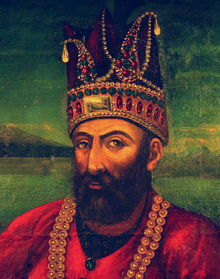
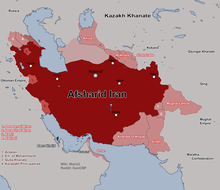
Iran's territorial integrity was restored by a native IranianTurkicAfsharwarlord from Khorasan,Nader Shah.He defeated and banished the Afghans,defeated the Ottomans,reinstalled the Safavids on the throne,and negotiated Russian withdrawal from Iran's Caucasian territories, with theTreaty of ReshtandTreaty of Ganja.By 1736, Nader had become so powerful he was able to depose the Safavids and have himself crowned shah. Nader was one of the last great conquerors of Asia and briefly presided over what was probably the most powerful empire in the world. To financially support his wars against Persia's arch-rival, theOttoman Empire,he fixed his sights on the weak but richMughal Empireto the east. In 1739, accompanied by his loyal Caucasian subjects includingErekle II,[126][127]: 55 heinvaded Mughal India,defeated a numerically superior Mughal army inless than three hours,andcompletely sacked and looted Delhi,bringing back immense wealth to Persia. On his way back, he also conquered all the Uzbek khanates – except forKokand– and made the Uzbeks his vassals. He also firmly re-established Persian rule over the entire Caucasus, Bahrain, as well as large parts of Anatolia and Mesopotamia. Undefeated for years, his defeat inDagestan,following guerrilla rebellions by theLezginsand the assassination attempt on him nearMazandaranis often considered the turning point in Nader's impressive career. To his frustration, the Dagestanis resorted to guerrilla warfare, and Nader with his conventional army could make little headway against them.[128]At theBattle of Andalaland the Battle of Avaria, Nader's army was crushingly defeated and he lost half of his entire force, as well forcing him to flee for the mountains.[129][better source needed]Though Nader managed to take most ofDagestanduring his campaign, the effective guerrilla warfare as deployed by the Lezgins, but also theAvarsandLaksmade the Iranian re-conquest of the particularNorth Caucasianregion this time a short lived one; several years later, Naderwas forced to withdraw.Around the same time, the assassination attempt was made on him near Mazandaran which accelerated the course of history; he slowly grew ill and megalomaniac, blinding his sons whom he suspected of the assassination attempts, and showing increasing cruelty against his subjects and officers. In his later years this eventually provoked multiple revolts and, ultimately, Nader's assassination in 1747.[130]
Nader's death was followed by aperiod of anarchy in Iran as rival army commanders fought for power.Nader's own family, the Afsharids, were soon reduced to holding on to a small domain in Khorasan. Many of the Caucasian territories broke away in variousCaucasian khanates.Ottomans regained lost territories in Anatolia and Mesopotamia.Omanand the Uzbek khanates ofBukharaandKhivaregained independence.Ahmad Shah Durrani,one of Nader's officers, founded an independent state which eventually became modern Afghanistan.Erekle IIandTeimuraz II,who, in 1744, had been made the kings ofKakhetiandKartlirespectively by Nader himself for their loyal service,[127]: 55 capitalized on the eruption of instability, and declaredde factoindependence. Erekle II assumed control over Kartli after Teimuraz II's death, thus unifying the two as theKingdom of Kartli-Kakheti,becoming the first Georgian ruler in three centuries to preside over a politically unified eastern Georgia,[131]and due to the frantic turn of events in mainland Iran he would be able to remainde factoautonomous through theZandperiod.[132]From his capitalShiraz,Karim Khanof theZand dynastyruled "an island of relative calm and peace in an otherwise bloody and destructive period,"[133]however the extent of Zand power was confined to contemporary Iran and parts of the Caucasus. Karim Khan's death in 1779 led to yet another civil war in which theQajar dynastyeventually triumphed and became kings of Iran. During the civil war, Iran permanently lostBasrain 1779 to the Ottomans, which had been captured during theOttoman–Persian War (1775–76),[134]andBahraintoAl Khalifa familyafterBani Utbah invasionin 1783.[citation needed] [check quotation syntax]
Late modern period
[edit]Qajar dynasty (1796–1925)
[edit]-
Qajar era currency bill with depiction ofNaser al-Din Shah Qajar.
-
A map of Iran under theQajar dynastyin the 19th century.
-
A map showing the 19th-century northwestern borders of Iran, comprising modern-day easternGeorgia,Dagestan,Armenia,and theRepublic of Azerbaijan,before being ceded to the neighboringRussian Empireby theRusso-Iranian wars.
Agha Mohammad Khanemerged victorious out of the civil war that commenced with the death of the last Zand king. His reign is noted for the reemergence of a centrally led and united Iran. After the death of Nader Shah and the last of the Zands, most of Iran's Caucasian territories had broken away into variousCaucasian khanates.Agha Mohammad Khan, like the Safavid kings and Nader Shah before him, viewed the region as no different from the territories in mainland Iran. Therefore, his first objective after having secured mainland Iran, was to reincorpate the Caucasus region into Iran.[135]Georgia was seen as one of the most integral territories.[132]For Agha Mohammad Khan, the resubjugation and reintegration of Georgia into the Iranian Empire was part of the same process that had broughtShiraz,Isfahan,andTabrizunder his rule.[132]As theCambridge History of Iranstates, its permanent secession was inconceivable and had to be resisted in the same way as one would resist an attempt at the separation ofFarsorGilan.[132]It was therefore natural for Agha Mohammad Khan to perform whatever necessary means in the Caucasus in order to subdue and reincorporate the recently lost regions following Nader Shah's death and the demise of the Zands, including putting down what in Iranian eyes was seen as treason on the part of thewali(viceroy) of Georgia, namely the Georgian kingErekle II(Heraclius II) who was appointed viceroy of Georgia by Nader Shah himself.[132]
Agha Mohammad Khan subsequently demanded that Heraclius II renounceits 1783 treaty with Russia,and to submit again to Persian suzerainty,[135]in return for peace and the security of his kingdom. The Ottomans, Iran's neighboring rival, recognized the latter's rights overKartliandKakhetifor the first time in four centuries.[136]Heraclius appealed then to his theoretical protector, EmpressCatherine II of Russia,pleading for at least 3,000 Russian troops,[136]but he was ignored, leaving Georgia to fend off the Persian threat alone.[137]Nevertheless, Heraclius II still rejected the Khan'sultimatum.[138]As a response, Agha Mohammad Khan invaded the Caucasus region after crossing theAras river,and, while on his way to Georgia, he re-subjugated Iran's territories of theErivan Khanate,Shirvan,Nakhchivan Khanate,Ganja khanate,Derbent Khanate,Baku khanate,Talysh Khanate,Shaki Khanate,Karabakh Khanate,which comprise modern-dayArmenia,Azerbaijan,Dagestan,andIgdir.Having reached Georgia with his large army, he prevailed in theBattle of Krtsanisi,which resulted in the capture and sack ofTbilisi,as well as the effective resubjugation of Georgia.[139][140]Upon his return from his successful campaign in Tbilisi and in effective control over Georgia, together with some 15,000 Georgian captives that were moved back to mainland Iran,[137]Agha Mohammad was formally crownedShahin 1796 in theMughan plain,just as his predecessor Nader Shah was about sixty years earlier.
Agha Mohammad Shah was later assassinated while preparing a second expedition against Georgia in 1797 inShusha[141](now part of theRepublic of Azerbaijan) and the seasoned king Heraclius died early in 1798. The reassertion of Iranian hegemony over Georgia did not last long; in 1799 the Russians marched into Tbilisi.[142]The Russians were already actively occupied with an expansionist policy towards its neighboring empires to its south, namely the Ottoman Empire and the successive Iranian kingdoms since the late 17th/early 18th century. The next two years following Russia's entrance into Tbilisi were a time of confusion, and the weakened and devastated Georgian kingdom, with its capital half in ruins, was easilyabsorbed by Russiain 1801.[137][138]As Iran could not permit or allow the cession ofTranscaucasiaand Dagestan, which had been an integral part of Iran for centuries,[10]this would lead directly to the wars of several years later, namely theRusso-Persian Warsof1804-1813and1826–1828.The outcome of these two wars (in theTreaty of Gulistanand theTreaty of Turkmenchay,respectively) proved for the irrevocable forced cession and loss of what is now easternGeorgia,Dagestan,Armenia,andAzerbaijanto Imperial Russia.[143][139]
The area to the north of the riverAras,among which the territory of the contemporary republic of Azerbaijan, eastern Georgia, Dagestan, and Armenia were Iranian territory until they were occupied by Russia in the course of the 19th century.[144]
-
Painting showing theBattle of Sultanabad,13 February 1812.State Hermitage Museum.
-
Storming of Lankaran,1812. Painted byFranz Roubaud.
-
Battle ofElisabethpol(Ganja), 1828. Franz Roubaud. Part of the collection of the Museum for History,Baku.
Migration of Caucasian Muslims
[edit]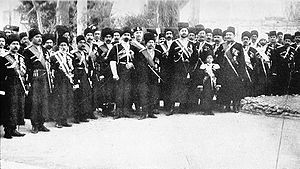
Following the official loss of vast territories in the Caucasus, major demographic shifts were bound to take place. Following the 1804–1814 war, but also per the 1826–1828 war which ceded the last territories, large migrations, so-calledCaucasian Muhajirs,set off to migrate to mainland Iran. Some of these groups included theAyrums,Qarapapaqs,Circassians,ShiaLezgins,and otherTranscaucasianMuslims.[145]
After theBattle of Ganja of 1804during theRusso-Persian War (1804–1813),many thousands of Ayrums and Qarapapaqs were settled in Tabriz. During the remaining part of the 1804–1813 war, as well as through the1826–1828 war,a large number of the Ayrums and Qarapapaqs that were still remaining in newly conquered Russian territories were settled in and migrated toSolduz(in modern-day Iran'sWest Azerbaijan province).[146]As theCambridge History of Iranstates; "The steady encroachment of Russian troops along the frontier in the Caucasus, GeneralYermolov's brutal punitive expeditions and misgovernment, drove large numbers of Muslims, and even some Georgian Christians, into exile in Iran. "[147]
From 1864 until the early 20th century,another mass expulsion took placeof Caucasian Muslims as a result of the Russian victory in theCaucasian War.Others simply voluntarily refused to live under Christian Russian rule, and thus departed for Turkey or Iran. These migrations once again, towards Iran, included masses of CaucasianAzerbaijanis,other Transcaucasian Muslims, as well as many North Caucasian Muslims, such as Circassians, Shia Lezgins andLaks.[145][148] Many of these migrants would prove to play a pivotal role in further Iranian history, as they formed most of the ranks of thePersian Cossack Brigade,which was established in the late 19th century.[149]The initial ranks of the brigade would be entirely composed ofCircassiansand other Caucasian Muhajirs.[149]This brigade would prove decisive in the following decades in Qajar history.
Furthermore, the 1828Treaty of Turkmenchayincluded the official rights for the Russian Empire to encourage settling ofArmeniansfrom Iran in the newly conquered Russian territories.[150][151]Until the mid-fourteenth century, Armenians had constituted a majority inEastern Armenia.[152] At the close of the fourteenth century, afterTimur's campaigns, theTimurid Renaissanceflourished, and Islam had become the dominant faith, and Armenians became a minority in Eastern Armenia.[152]After centuries of constant warfare on theArmenian Plateau,many Armenians chose to emigrate and settle elsewhere. FollowingShah Abbas I's massive relocation of Armenians and Muslims in 1604–05,[153]their numbers dwindled even further.
At the time of the Russian invasion of Iran, some 80% of the population ofIranian Armeniawere Muslims (Persians,Turkics,andKurds) whereas ChristianArmeniansconstituted a minority of about 20%.[154]As a result of theTreaty of Gulistan(1813) and the Treaty of Turkmenchay (1828), Iran was forced to cede Iranian Armenia (which also constituted the present-dayArmenia), to the Russians.[155][156]After the Russian administration took hold of Iranian Armenia, the ethnic make-up shifted, and thus for the first time in more than four centuries, ethnic Armenians started to form a majority once again in one part of historic Armenia.[157]The new Russian administration encouraged the settling of ethnic Armenians from Iran proper andOttoman Turkey.As a result, by 1832, the number of ethnic Armenians had matched that of the Muslims.[154]It would be only after theCrimean Warand theRusso-Turkish War of 1877–1878,which brought another influx of Turkish Armenians, that ethnic Armenians once again established a solid majority inEastern Armenia.[158]Nevertheless, the city of Erivan retained a Muslim majority up to the twentieth century.[158]According to the travellerH. F. B. Lynch,the city of Erivan was about 50% Armenian and 50% Muslim (Tatars[a]i.e. Azeris and Persians) in the early 1890s.[161]
Fath Ali Shah's reign saw increased diplomatic contacts with the West and the beginning of intense European diplomatic rivalries over Iran. His grandsonMohammad Shah,who succeeded him in 1834, fell under the Russian influence and made two unsuccessful attempts to captureHerat.When Mohammad Shah died in 1848 the succession passed to his sonNaser al-Din Shah Qajar,who proved to be the ablest and most successful of the Qajar sovereigns. He founded the first modern hospital in Iran.[162]
Constitutional Revolution and deposition
[edit]TheGreat Persian Famine of 1870–1871is believed to have caused the death of two million people.[163]
A new era in the history of Persia dawned with thePersian Constitutional Revolutionagainst the Shah in the late 19th and early 20th centuries. The Shah managed to remain in power, granting a limited constitution in 1906 (making the country aconstitutional monarchy). The firstMajlis(parliament) was convened on October 7, 1906.
The discovery ofpetroleumin 1908 by the British inKhuzestanspawned intense renewed interest in Persia by theBritish Empire(seeWilliam Knox D'ArcyandAnglo-Iranian Oil Company,nowBP). Control of Persia remained contested between the United Kingdom and Russia, in what became known asThe Great Game,and codified in theAnglo-Russian Convention of 1907,which divided Persia into spheres of influence, regardless of her national sovereignty.
During World War I, the country was occupied by British, Ottoman and Russian forces but was essentially neutral (seePersian Campaign). In 1919, after theRussian Revolutionand their withdrawal, Britain attempted to establish aprotectoratein Persia, which was unsuccessful.
Finally, theConstitutionalist movement of Gilanand the central power vacuum caused by the instability of the Qajar government resulted in the rise of Reza Khan, who was later to becomeReza Shah Pahlavi,and the subsequent establishment of thePahlavi dynastyin 1925. In 1921, a militarycoupestablished Reza Khan, an officer of thePersian Cossack Brigade,as the dominant figure for the next 20 years.Seyyed Zia'eddin Tabatabaiwas also a leader and important figure in the perpetration of the coup. The coup was not actually directed at the Qajar monarchy; according toEncyclopædia Iranica,it was targeted at officials who were in power and actually had a role in controlling the government — the cabinet and others who had a role in governing Persia.[164]In 1925, after being prime minister for two years, Reza Khan became the first shah of the Pahlavi dynasty.
Pahlavi era (1925–1979)
[edit]Reza Shah (1925–1941)
[edit]Reza Shahruled for almost 16 years until September 16, 1941, when he was forced toabdicateby theAnglo-Soviet invasion of Iran.He established anauthoritarian governmentthat valuednationalism,militarism,secularismandanti-communismcombined with strictcensorshipandstate propaganda.[165]Reza Shah introduced many socio-economic reforms, reorganizing the army, government administration, and finances.[166]
To his supporters, his reign brought "law and order, discipline, central authority, and modern amenities – schools, trains, buses, radios, cinemas, and telephones".[167]However, his attempts of modernisation have been criticised for being "too fast"[168]and "superficial",[169]and his reign a time of "oppression, corruption, taxation, lack of authenticity" with "security typical ofpolice states."[167]
Many of the new laws and regulations created resentment among devout Muslims and the clergy. For example, mosques were required to use chairs; most men were required to wear western clothing, including a hat with a brim; women were encouraged to discard thehijab—hijab was eventuallybanned in 1936;men and women were allowed to congregate freely, violating Islamicmixing of the sexes.Tensions boiled over in 1935, when bazaaris and villagers rose upin rebellionat theImam Reza shrineinMashhadto protest against plans for the hijab ban, chanting slogans such as 'The Shah is a newYezid.' Dozens were killed and hundreds were injured when troops finally quelled the unrest.[170]
World War II
[edit]WhileGerman armies were highly successfulagainst theSoviet Union,the Iranian government expected Germany to win the war and establish a powerful force on its borders. It rejected British and Soviet demands to expel German residents from Iran. In response, the twoAlliesinvaded in August 1941and easily overwhelmed the weak Iranian army inOperation Countenance.Iran became the major conduit of AlliedLend-Leaseaid to the Soviet Union. The purpose was to secure Iranianoil fieldsand ensure Alliedsupply lines(seePersian Corridor). Iran remained officially neutral. Its monarchRezā Shāhwas deposed during the subsequent occupation and replaced with his young sonMohammad Reza Pahlavi.[171]
At theTehran Conference of 1943,the Allies issued theTehran Declarationwhich guaranteed the post-war independence and boundaries of Iran. However, when the war actually ended, Soviet troops stationed in northwestern Iran not only refused to withdraw but backed revolts that established short-lived, pro-Soviet separatist national states in the northern regions of Azerbaijan andIranian Kurdistan,theAzerbaijan People's Governmentand theRepublic of Kurdistanrespectively, in late 1945. Soviet troops did not withdraw from Iran proper until May 1946 after receiving a promise of oil concessions. The Soviet republics in the north were soonoverthrownand the oil concessions were revoked.[172][173]
Mohammad-Reza Shah (1941–1979)
[edit]
Initially there were hopes that post-occupation Iran could become aconstitutional monarchy.The new, young ShahMohammad Reza Shah Pahlaviinitially took a very hands-off role in government, and allowedparliamentto hold a lot of power. Some elections were held in the first shaky years, although they remained mired in corruption. Parliament became chronically unstable, and from the 1947 to 1951 period Iran saw the rise and fall of six different prime ministers. Pahlavi increased his political power by convening theIran Constituent Assembly, 1949,which finally formed theSenate of Iran—a legislativeupper houseallowed for in the 1906 constitution but never brought into being. The new senators were largely supportive of Pahlavi, as he had intended.
In 1951 Prime MinisterMohammed Mosaddeqreceived the vote required from the parliament tonationalizethe British-owned oil industry, in a situation known as theAbadan Crisis.Despite British pressure, including an economic blockade, the nationalization continued. Mosaddeq was briefly removed from power in 1952 but was quickly re-appointed by the Shah, due to a popular uprising in support of the premier, and he, in turn, forced the Shah into a brief exile in August 1953 after a failed military coup byImperial GuardColonelNematollah Nassiri.
1953: U.S. aided coup removes Mosaddeq
[edit]Shortly thereafter on August 19 a successfulcoupwas headed by retired army generalFazlollah Zahedi,aided by the United States (CIA)[174]with the active support of the British (MI6) (known asOperation Ajax and Operation Bootto the respective agencies).[175]The coup—with ablack propagandacampaign designed to turn the population against Mosaddeq[176]— forced Mosaddeq from office. Mosaddeq was arrested and tried for treason. Found guilty, his sentence was reduced to house arrest on his family estate while his foreign minister,Hossein Fatemi,was executed.Zahedisucceeded him as prime minister, and suppressed opposition to the Shah, specifically theNational Frontand CommunistTudeh Party.
Iran was ruled as an autocracy under the Shah with American support from that time until the revolution. The Iranian government entered into agreement with an international consortium of foreign companies which ran the Iranian oil facilities for the next 25 years, splitting profits fifty-fifty with Iran but not allowing Iran to audit their accounts or have members on their board of directors. In 1957 martial law was ended after 16 years and Iran became closer to the West, joining theBaghdad Pactand receiving military and economic aid from the US. In 1961, Iran initiated a series of economic, social, agrarian and administrative reforms to modernize the country that became known as the Shah'sWhite Revolution.
The core of this program was land reform. Modernization and economic growth proceeded at an unprecedented rate, fueled by Iran's vast petroleum reserves, the third-largest in the world. However, the reforms, including the White Revolution, did not greatly improve economic conditions and the liberal pro-Western policies alienated certainIslamicreligious and political groups. In early June 1963several days of massive riotingoccurred in support ofAyatollahRuhollah Khomeinifollowing the cleric's arrest for a speech attacking the Shah.
Two years later, premierHassan Ali Mansurwas assassinated and the internal security service,SAVAK,became more violently active. In the 1970s, leftistguerilla groupssuch asMujaheddin-e-Khalq(MEK), emerged and contributed to overthrowing the Shah during the 1979 Iranian Revolution.
Nearly a hundred Iran political prisoners were killed by the SAVAK during the decade before the revolution and many more were arrested and tortured.[177]The Islamic clergy, headed by the AyatollahRuhollah Khomeini(who had been exiled in 1964), were becoming increasingly vociferous.
Iran greatly increased its defense budget and by the early 1970s was the region's strongest military power. Bilateral relations with Iraq were not good, mainly due to a dispute over theShatt al-Arabwaterway. In November 1971, Iranian forces seized control of three islands at the mouth of the Persian Gulf; in response, Iraq expelled thousands of Iranian nationals. Following a number of clashes in April 1969, Iran abrogated the 1937 accord and demanded a renegotiation.
In mid-1973, the Shah returned the oil industry to national control. Following theArab-Israeli War of October 1973,Iran did not join the Arab oil embargo against the West andIsrael.Instead, it used the situation to raise oil prices, using the money gained for modernization and to increase defense spending.
A border dispute between Iraq and Iran was resolved with the signing of theAlgiers Accordon March 6, 1975.
Contemporary period
[edit]Revolution and the Islamic Republic (1979 to present)
[edit]
TheIranian Revolution,also known as theIslamic Revolution,[178]was therevolutionthat transformed Iran from an absolutemonarchyunderShahMohammad Reza Pahlavito anIslamic republicunder AyatollahRuhollah Khomeini,one of the leaders of the revolution and founder of the Islamic Republic.[9]Its time span can be said to have begun in January 1978 with the first major demonstrations,[179]and concluded with the approval of the newtheocraticConstitution—whereby Ayatollah Khomeini becameSupreme Leaderof the country—in December 1979.[180]
In between,Mohammad Reza Pahlavileft the country for exile in January 1979 after strikes and demonstrations paralyzed the country, and on February 1, 1979, Ayatollah Khomeini returned to Tehran.[180]The final collapse of the Pahlavi dynasty occurred shortly after on February 11 when Iran's military declared itself "neutral" after guerrillas and rebel troops overwhelmed troops loyal to the Shah in armed street fighting. Iran officially became an Islamic Republic on April 1, 1979,after Iranians overwhelmingly approved a national referendum to make it so a day before.[181]
Ideology of the 1979 Iranian Revolution
[edit]The ideology of the revolutionary government was populist, nationalist and most of allShi'a Islamic.Its unique constitution is based on the concept ofvelayat-e faqihthe idea advanced by Khomeini that Muslims – in fact everyone – requires "guardianship", in the form of rule or supervision by the leadingIslamic juristor jurists.[182]Khomeini served as this ruling jurist, orsupreme leader,until his death in 1989.
Iran's rapidly modernising, capitalist economy was replaced by populist and Islamic economic and cultural policies. Much industry wasnationalized,laws and schools Islamicized, and Western influences banned.
The Islamic revolution also created great impact around the world. In the non-Muslim world it has changed the image of Islam, generating much interest in the politics and spirituality of Islam,[183]along with "fear and distrust towards Islam" and particularly the Islamic Republic and its founder.[184]
Khomeini (1979–1989)
[edit]Khomeini served as leader of the revolution or asSupreme Leader of Iranfrom 1979 to his death on June 3, 1989. This era was dominated by the consolidation of the revolution into atheocraticrepublic under Khomeini, and by the costly and bloodywar with Iraq.
The consolidation lasted until 1982–3,[185][186]as Iran coped with the damage to its economy, military, and apparatus of government, and protests and uprisings by secularists, leftists, and more traditional Muslims—formerly ally revolutionaries but now rivals—were effectively suppressed. Many political opponents were executed by the new regimes. Following the events of the revolution, Marxist guerrillas and federalist parties revolted in regions comprisingKhuzistan,KurdistanandGonbad-e Qabus,resulting in severe fighting between rebels and revolutionary forces. These revolts began in April 1979 and lasted between several months to over a year, depending on the region. TheKurdish uprising,led by the KDPI, was the most violent, lasting until 1983 and resulting in 10,000 casualties.
In the summer of 1979 a new constitution giving Khomeini a powerful post as guardian juristSupreme Leader[187]and a clericalCouncil of Guardianspower over legislation and elections, was drawn up by anAssembly of Experts for Constitution.The new constitution was approved by referendum in December 1979.
Iran hostage crisis (1979–1981)
[edit]An early event in the history of the Islamic republic that had a long-term impact was theIran hostage crisis.Following the admitting of the former Shah of Iran into the United States for cancer treatment, on November 4, 1979, Iranian studentsseized US embassy personnel,labeling the embassy a "den of spies."[188]Fifty-two hostages were held for 444 days until January 1981.[189]An Americanmilitary attempt to rescue the hostagesfailed.[190]
The takeover was enormously popular in Iran, where thousands gathered in support of the hostage takers, and it is thought to have strengthened the prestige of theAyatollah Khomeiniand consolidated the hold of anti-Americanism. It was at this time that Khomeini began referring to America as the "Great Satan."In America, where it was considered a violation of the long-standing principle of international law thatdiplomatsmay be expelled but not held captive, it created a powerful anti-Iranian backlash. Relations between the two countries have remained deeply antagonistic and Americaninternational sanctionshave hurt Iran's economy.[191]
Iran–Iraq War (1980–1988)
[edit]
During this political and social crisis, Iraqi leaderSaddam Husseinattempted to take advantage of the disorder of the Revolution, the weakness of the Iranian military and the revolution's antagonism with Western governments. The once-strong Iranian military had been disbanded during the revolution, and with the Shah ousted, Hussein had ambitions to position himself as the new strong man of the Middle East. He sought to expand Iraq's access to the Persian Gulf by acquiring territories that Iraq had claimed earlier from Iran during the Shah's rule.
Of chief importance to Iraq wasKhuzestanwhich not only boasted a substantial Arab population, but rich oil fields as well. On the unilateral behalf of theUnited Arab Emirates,the islands ofAbu Musaand theGreater and Lesser Tunbsbecame objectives as well. With these ambitions in mind, Hussein planned a full-scale assault on Iran, boasting that his forces could reach the capital within three days. On September 22, 1980, the Iraqi army invaded Iran at Khuzestan, precipitating theIran–Iraq War.The attack took revolutionary Iran completely by surprise.
Although Saddam Hussein's forces made several early advances, Iranian forces had pushed the Iraqi army back into Iraq by 1982. Khomeini sought toexport his Islamic revolutionwestward into Iraq, especially on the majority Shi'a Arabs living in the country. The war then continued for six more years until 1988, when Khomeini, in his words, "drank the cup of poison" and accepted a truce mediated by the United Nations.
Tens of thousands of Iranian civilians and military personnel were killed when Iraq usedchemical weaponsin its warfare.Iraq was financially backedbyEgypt,the Arab countries of thePersian Gulf,the Soviet Union and theWarsaw Pactstates, the United States (beginning in 1983), France, the United Kingdom, Germany,Brazil,and thePeople's Republic of China(which also sold weapons to Iran).
There were more than 182,000 Kurdish victims[192]of Iraq's chemical weapons during the eight-year war. The total Iranian casualties of the war were estimated to be between 500,000 and 1,000,000. Almost all relevant international agencies have confirmed that Saddam engaged in chemical warfare to blunt Iranianhuman wave attacks;these agencies unanimously confirmed that Iran never used chemical weapons during the war.[193][194][195][196]
Starting on 19 July 1988 and lasting for about five months thegovernmentsystematically executed thousands of political prisoners across Iran. This is commonly referred to as the1988 executions of Iranian political prisonersor the 1988 Iranian Massacre. The main target was the membership of thePeople's Mojahedin Organization of Iran(PMOI), although a lesser number of political prisoners from other leftist groups were also included such as theTudeh Party of Iran(Communist Party).[197][198]Estimates of the number executed vary from 1,400[199]to 30,000.[200][201]
Khamenei (1989–present)
[edit]On his deathbed in 1989,Khomeiniappointed a 25-man Constitutional Reform Council which named then presidentAli Khameneias the next Supreme Leader, and made a number of changes to Iran's constitution.[202]A smooth transition followed Khomeini's death on June 3, 1989. While Khamenei lacked Khomeini's "charisma and clerical standing", he developed a network of supporters within Iran's armed forces and its economically powerfulreligious foundations.[203]Under his reign Iran's regime is said – by at least one observer – to resemble more "a clerical oligarchy... than an autocracy."[203]
Rafsanjani: pragmatic conservativism (1989–1997)
[edit]Ali-Akbar Hashemi Rafsanjanisucceeded Khamenei as president on August 3, 1989, as a pragmatic conservative who served two four-year terms and focused his efforts on rebuilding the country's economy and infrastructure damaged by war, though hampered by low oil prices. Rafsanjani sought to restore confidence in the government among the general population by privatizing the companies that had been nationalized in the first few years of the Islamic Republic, as well as by bringing in qualified technocrats to manage the economy. The state of their economy also influenced the government to move towards ending their diplomatic isolation. This was achieved through the reestablishment of normalized relations with neighbors such asSaudi Arabiaand an attempt to improve its reputation in the region with assertions that its revolution was not exportable to other states.[204]During thePersian Gulf Warin 1991 the country remainedneutral,restricting its action to the condemnation of the U.S. and allowing fleeing Iraqi aircraft and refugees into the country.
Iran in the 1990s had a greater secular behavior and admiration for Western popular culture than in the previous decades. This admiration had become a way in which the urban population expressed their resentment at the invasive Islamic policies of the government.[205]The pressures from the population placed on the new Supreme Leader AyatollahAli Khameneiled to an uneasy alliance between him and PresidentAkbar Hashemi Rafsanjani.Through this alliance they attempted to hinder theulama's ability to gain further control of the state. In 1989, they created a sequence of constitutional amendments that removed the office of prime minister and increased the scope of presidential power. However, these new amendments did not curtail the powers of theSupreme Leader of Iranin any way; this position still contained the ultimate authority over the armed forces, the making of war and peace, the final say in foreign policy, and the right to intervene in the legislative process whenever he deemed it necessary.[205]
Khatami: reformers and conservatives struggle (1997–2005)
[edit]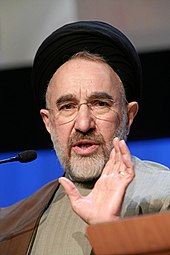
President Rafsanjani's economic policies led to stronger relations with the outside world. But his government's relaxation of the enforcement of certain regulations on social behavior were met with some responses of widespread disenchantment among the general population with the ulama as rulers of the country.[205]This led to the defeat of the government's candidate for president in 1997, who had the backing of the supreme Islamic jurist. He was beaten by an independent candidate from theReformists,Mohammad Khatami.He received 69% of the vote and enjoyed particular support from two groups of the population that had felt ostracized by the practices of the state: women and youth. The younger generations in the country had been too young to experience the shah's regime or the revolution that ended it, and now they resented the restrictions placed on their daily lives under the Islamic Republic. Mohammad Khatami's presidency was soon marked by tensions between thereform-minded governmentand an increasingly conservative and vocal clergy. This rift reached a climax in July 1999 when massive anti-government protests erupted in the streets ofTehran.The disturbances lasted over a week before police and pro-government vigilantes dispersed the crowds.
Khatami was re-elected in June 2001 but his efforts were repeatedly blocked by the conservatives in the parliament. Conservative elements within Iran's government moved to undermine the reformist movement, banning liberal newspapers and disqualifying candidates for parliamentary elections. This clampdown on dissent, combined with the failure of Khatami to reform the government, led to growing political apathy among Iran's youth.
In June 2003, anti-government protests by several thousand students took place in Tehran.[206][207]Severalhuman rightsprotests also occurred in 2006.
Ahmadinejad: hardline conservatism (2005–2009)
[edit]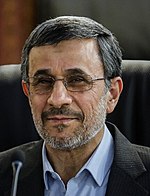
In the2005 Iranian presidential election,Mahmoud Ahmadinejad,mayor of Tehran, became the sixth president of Iran, after winning 62 percent of the vote in therun-off poll,against former president Ali-Akbar Hashemi Rafsanjani.[208]During the authorization ceremony he kissed Khamenei's hand in demonstration of his loyalty to him.[209][210]
During this time, the American invasion of Iraq, the overthrow ofSaddam Hussein's regime and empowerment of itsShi'amajority, all strengthened Iran's position in the region particularly in the mainly Shi'a south of Iraq, where a top Shia leader in the week of September 3, 2006 renewed demands for an autonomous Shi'a region.[211]At least one commentator (former U.S. Defense SecretaryWilliam S. Cohen) has stated that as of 2009 Iran's growing power has eclipsedanti-Zionismas the major foreign policy issue in the Middle East.[212]
During 2005 and 2006, there were claims thatthe United StatesandIsraelwere planning to attack Iran, with the most cited reason beingIran's civilian nuclear energy programwhich the United States and some other states fear could lead toa nuclear weapons program.China and Russia opposed military action of any sort and opposedeconomic sanctions.Khamenei issued afatwaforbidding the production, stockpiling and use ofnuclear weapons.The fatwa was cited in an official statement by the Iranian government at an August 2005 meeting of theInternational Atomic Energy Agency(IAEA) inVienna.[213][214]
In 2009,Ahmadinejad's reelectionwas hotly disputed and marred by largeproteststhat formed the "greatest domestic challenge" to the leadership of the Islamic Republic "in 30 years". The resulting social unrest is widely known as theIranian Green Movement.[215]Reformist opponentMir-Hossein Mousaviand his supporters alleged voting irregularities and by 1 July 2009, 1000 people had been arrested and 20 killed in street demonstrations.[216]Supreme LeaderAli Khameneiand other Islamic officials blamed foreign powers for fomenting the protest.[217]
Rouhani: pragmatism (2013–2021)
[edit]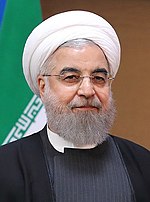
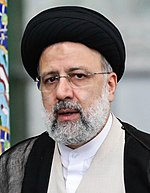
On 15 June 2013,Hassan Rouhaniwon the presidential election in Iran, with a total number of 36,704,156 ballots cast; Rouhani won 18,613,329 votes. In his press conference one day after election day, Rouhani reiterated his promise to recalibrate Iran's relations with the world.[218]
On April 2, 2015, following eight days of tortuous discussions in Switzerland, which lasted through the night, Iran and six world powers (United States, United Kingdom, France, China and Russia plus Germany)agreedon the outlines of an understanding to limit Iran's nuclear programs, negotiators indicated, as both sides prepared for announcements. Iranian Foreign Minister MohammadJavad Zariftweeted: "Found solutions. Ready to start drafting immediately." European Union foreign policy chiefFederica Mogherinitweeted that she would meet the press with Zarif after a final meeting of the seven nations in the nuclear talks. She wrote: "Good news."
Reading out a joint statement, European Union foreign policy chief Federica Mogherini hailed what she called a "decisive step" after more than a decade of work. Iranian Foreign Minister Mohammad Javad Zarif followed with the same statement inPersian.U.S. Secretary of State John Kerryand the top diplomats of Britain, France and Germany also briefly took the stage behind them. The deal is intended to be a provisional framework for a comprehensive agreement and was signed in 2015, and marked a significant breakthrough in the 12-year history of negotiations with Iran over its nuclear programme.[219]
WhenDonald Trumpwas campaigning to becomePresident of the US,he repeatedly said he would abandon theIran nuclear deal.After he was elected president, the USA announced its withdrawal from the agreement on 8 May 2018.[220]
The Iranian-backed group known as Kataib Hezbollah attacked the United States embassy in Baghdad on December 31, 2019.[221]
On January 3, 2020, the United States military executed a drone strike atBaghdad Airport,killingQasem Soleimani,the leader of theQuds Force,an elite branch of theIslamic Revolutionary Guard Corps.[222]
On 3 August 2021Ebrahim Raisiwas elected 8th President of Iran.[223]
Ebrahim Raisi (2021–2024)
[edit]Beginning on 16 September 2022protestsstarted against thegovernment of Iranfollowing the death ofMahsa Amini (Jina).[224][225][226]
On 1 April 2024, Israel's airstrikeon an Iranian consulate building in the Syrian capital Damascus killed an important senior commander of theIslamic Revolutionary Guards Corps(IRGC), Brig GenMohammad Reza Zahedi.[227]In retaliation for the Israeli strike, IranattackedIsrael with over 300 drones and missiles on 13 April. However, the Iranian attack was mainly intercepted either outside Israeli airspace or over the country itself. It was the biggest missile attack in Iranian history, and its first ever direct attack on Israel.[228]It was followed by a retaliatorymissile strikeby Israel on Isfahan, Iran on 19 April.[229]
See also
[edit]- List of monarchs of Persia
- Outline of Iran
- Politics of Iran
- Iranian religions
- Safavid conversion of Iran to Shia Islam
- Timeline of Tehran
- Timeline of the Iranian Revolution
- Timeline of Iranian history
- General
Notes
[edit]- ^The term "Tatars", employed by the Russians, referred toTurkish-speakingMuslims (Shia andSunni) ofTranscaucasia.[159]Unlike Armenians andGeorgians,the Tatars did not have their own alphabet and used thePerso-Arabic script.[159]After 1918 with the establishment of theAzerbaijan Democratic Republic,and "especially during theSovietera ", the Tatar group identified itself as"Azerbaijani".[159]Prior to 1918 the word "Azerbaijan"exclusively referred to theIranian province of Azarbayjan.[160]
References
[edit]- ^People, "New evidence: modern civilization began in Iran", 10 Aug 2007Archived24 February 2021 at theWayback Machine,retrieved 1 October 2007
- ^Azadpour, M."HEGEL, GEORG WILHELM FRIEDRICH".Encyclopædia Iranica.Archivedfrom the original on 11 April 2015.Retrieved11 April2015.
- ^https://www.britannica.com/ebc/article-9371723Archived2008-04-29 at theWayback MachineEncyclopædia Britannica Concise Encyclopedia Article: Media
- ^David Sacks, Oswyn Murray, Lisa R. Brody; Oswyn Murray; Lisa R. Brody (2005).Encyclopedia of the Ancient Greek World.Infobase Publishing. pp. 256 (at the right portion of the page).ISBN978-0-8160-5722-1.Archivedfrom the original on 26 January 2021.Retrieved17 October2020.
{{cite book}}:CS1 maint: multiple names: authors list (link) - ^Baten, Jörg (2016).A History of the Global Economy. From 1500 to the Present.Cambridge University Press. p. 214.ISBN978-1-107-50718-0.
- ^abcdR. M. Savory, "Safavids",Encyclopedia of Islam,2nd edition
- ^"The Islamic World to 1600",Applied History Research Group, University of Calgary, 1998Archived2008-06-12 at theWayback Machine,retrieved 1 October 2007
- ^"Iran Islamic Republic",Archived2006-03-16 at theWayback Machine,Encyclopædia Britannica,retrieved 23 January 2008
- ^abEncyclopædia Britannica23 January 2008ArchivedDecember 15, 2007, at theWayback Machine
- ^abFisher et al. 1991,pp. 329–330.
- ^Dowling, Timothy C. (2014).Russia at War: From the Mongol Conquest to Afghanistan, Chechnya, and Beyond.2 volumes. ABC-CLIO. pp. 728–729.ISBN978-1-59884-948-6.
- ^Ancient Iran,Encyclopædia Britannica,www.britannica.com
- ^Biglari, Fereidoun; Shidrang, Sonia (2019)."Rescuing the Paleolithic Heritage of Hawraman, Kurdistan, Iranian Zagros".Near Eastern Archaeology.82(4): 226–235.doi:10.1086/706536.ISSN1094-2076.S2CID212851965.
- ^J.D. Vigne, J. Peters and D. Helmer,First Steps of Animal Domestication,Proceedings of the 9th Conference of the International Council of Archaeozoology, Durham, August 2002,ISBN1-84217-121-6
- ^TRINKAUS, E.; BIGLARI, F."Middle Paleolithic Human Remains from Bisitun Cave, Iran".Archivedfrom the original on 27 July 2016.Retrieved6 November2021.
- ^"Early humans in Iran were growing wheat 12,000 years ago".NBC.news.5 July 2013.Archivedfrom the original on 2 November 2020.Retrieved10 September2014.
- ^Riehl, Simone."Emergence of Agriculture in the Foothills of the Zagros Mountains of Iran (Supplement)".www.researchgate.net.Archivedfrom the original on 3 May 2019.Retrieved1 March2015.
- ^"Excavations at Chogha Bonut: The earliest village in Susiana".University of Chicago.Archivedfrom the original on 25 July 2013.Retrieved21 June2013.
- ^Hole, Frank (20 July 2004)."Neolithic Age in Iran".Encyclopedia Iranica.Encyclopaedia Iranica Foundation.Archivedfrom the original on 23 October 2012.Retrieved9 August2012.
- ^ab"Iran, 8000–2000 BC".The Timeline of Art History.The Metropolitan Museum of Art. October 2000.Archivedfrom the original on 5 March 2001.Retrieved9 August2008.
- ^"Ancient Iran Museum".Ali Majdfar, photography.Archivedfrom the original on 26 July 2013.Retrieved27 March2008.
{{cite web}}:CS1 maint: others (link) - ^abcPotts, D. T. (1999).The Archaeology of Elam: Formation and Transformation of an Ancient Iranian State.Cambridge University Press.ISBN0-521-56358-5.
- ^abXinhua, "New evidence: modern civilization began in Iran", 10 Aug 2007Archived23 November 2016 at theWayback Machine,retrieved 1 October 2007
- ^K. Kris Hirst."Chogha Mish (Iran)".Archivedfrom the original on 6 November 2013.Retrieved11 June2010.
- ^"Penn Museum – University of Pennsylvania Museum of Archaeology and Anthropology".Archived fromthe originalon 16 December 2008.
- ^Smith, Philip E. L. (1990). "Architectural Innovation and Experimentation at Ganj Dareh, Iran".World Archaeology.21(3): 323–335.doi:10.1080/00438243.1990.9980111.ISSN0043-8243.JSTOR124833.
- ^Kushnareva, K. Kh. (1997).The Southern Caucasus in Prehistory: Stages of Cultural and Socioeconomic Development from the Eighth to the Second Millennium B.C.UPenn Museum of Archaeology.ISBN978-0-924171-50-5.Archivedfrom the original on 13 September 2020.Retrieved8 May2016.,page 44
- ^Sagona, Antonio; Zimansky, Paul (24 February 2015).Ancient Turkey.Routledge.ISBN978-1-134-44027-6.Archivedfrom the original on 6 September 2020.Retrieved8 May2016.,page 163
- ^Algaze, Guillermo. 2005. The Uruk World System: The Dynamics of Expansion of Early Mesopotamian Civilization
- ^Robert A. Carter; Graham Philip, eds. (2010) [2006].Beyond the Ubaid: transformation and integration in the late prehistoric societies of the Middle East(PDF).Studies in Ancient Oriental Civilization. Vol. 63. Ann Arbor: University of Chicago Press.ISBN978-1-885923-66-0.Archived(PDF)from the original on 21 March 2014.
- ^"5000-Y-Old Inscribed Tablets Discovered in Jiroft".Archived fromthe originalon 11 May 2011.
- ^"New Discoveries in Jiroft May Change History of Civilization".Cultural Heritage News Agency. 26 January 2006. Archived fromthe originalon 11 April 2008.Retrieved16 March2023.
- ^Yarshater, Yarshater."Iranian history".Encyclopædia Iranica.Archivedfrom the original on 3 February 2021.Retrieved23 June2008.
- ^Diakonoff, I., M., "Media", Cambridge History of Iran, II, Cambridge, 1985, p.43 [within the pp.36–148].This paper is cited in the Journal of Eurasian Studies on page 51.
- ^Lackenbacher, Sylvie."Elam".Encyclopædia Iranica.Archivedfrom the original on 18 November 2020.Retrieved23 June2008.
- ^^ Bahman Firuzmandi "Mad, Hakhamanishi, Ashkani, Sasani" pp. 20
- ^ab"Iran, 1000 BC–1 AD".The Timeline of Art History.The Metropolitan Museum of Art. October 2000.Archivedfrom the original on 25 January 2021.Retrieved9 August2008.
- ^Medvedskaya, I.N. (January 2002)."The Rise and Fall of Media".International Journal of Kurdish Studies.BNET. Archived fromthe originalon 28 March 2008.Retrieved10 August2008.
- ^Sicker, Martin (2000).The pre-Islamic Middle East.Greenwood Publishing Group. pp. 68/69.ISBN978-0-275-96890-8.
- ^Urartu – Lost Kingdom of VanArchived2015-07-02 at theWayback Machine
- ^"Urartu Civilization – All About Turkey".Archivedfrom the original on 1 July 2015.Retrieved18 June2015.
- ^"Forgotten Empire— the world of Ancient Persia".The British Museum. 2005. Archived fromthe originalon 23 April 2007.Retrieved16 March2023.
- ^Hooker, Richard (1996)."The Persians".Archived fromthe originalon 29 August 2006.Retrieved20 August2006.
- ^"Engineering an Empire: The Persians | Anthropology.net".Archived fromthe originalon 10 January 2007.Retrieved13 March2007.
- ^"Greek-Persian Wars (490 bce–479 bce) - Gale Encyclopedia of World History: War - Encyclopedia.com".Archivedfrom the original on 4 September 2009.Retrieved13 March2007.
- ^Benevolent Persian EmpireArchived2005-09-07 at theWayback Machine
- ^abcRoisman & Worthington 2011,p. 345.
- ^Carey, Brian Todd; Allfree, Joshua B.; Cairns, John (19 January 2006).Warfare in the Ancient World.Pen and Sword.ISBN978-1-84884-630-2.
- ^Aeschylus; Peter Burian; Alan Shapiro (17 February 2009).The Complete Aeschylus: Volume II: Persians and Other Plays.Oxford University Press. p. 18.ISBN978-0-19-045183-7.Archivedfrom the original on 23 September 2020.Retrieved12 September2016.
- ^Roisman & Worthington 2011,pp. 135–138, 342–345.
- ^Norman A. StillmanThe Jews of Arab Landspp 22 Jewish Publication Society, 1979ISBN0827611552
- ^International Congress of Byzantine StudiesProceedings of the 21st International Congress of Byzantine Studies, London, 21–26 August 2006, Volumes 1–3pp 29. Ashgate Pub Co, 30 September 2006ISBN075465740X
- ^Garthwaite, Gene R.,The Persians,p. 2
- ^J. B. Bury, p.109.
- ^abDurant.
- ^"Compareti – Sasanians in Africa – Transoxiana 4".Archivedfrom the original on 28 May 2008.Retrieved5 March2007.
- ^Sarfaraz, pp. 329–330.
- ^"Iransaga – Persian Art, The Sassanians".Archivedfrom the original on 23 November 2019.Retrieved5 March2007.
- ^Zarinkoob, p.305.
- ^"Iran".Encyclopædia Britannica.Archivedfrom the original on 13 August 2013.Retrieved21 June2007.
- ^abLewis, Bernard."Iran in history".Tel Aviv University.Archived fromthe originalon 29 April 2007.Retrieved3 April2007.
- ^Hawting G.,The First Dynasty of Islam. The Umayyad Caliphate AD 661–750,(London) 1986, pp. 63–64
- ^Cambridge History of Iran,byRichard Nelson Frye,Abdolhosein Zarrinkoub,et al. Section on The Arab Conquest of Iran and. Vol 4, 1975. London. p.46
- ^Al-Biruni.الآثار الباقية عن القرون الخالية, p.35,36,48 وقتی قتبیه بن مسلم سردار حجاج، بار دوم بخوارزم رفت و آن را باز گشود هرکس را که خط خوارزمی می نوشت و از تاریخ و علوم و اخبار گذشته آگاهی داشت از دم تیغ بی دریغ درگذاشت و موبدان و هیربدان قوم را یکسر هلاک نمود و کتابهاشان همه بسوزانید و تباه کرد تا آنکه رفته رفته مردم امی ماندند و از خط و کتابت بی بهره گشتند و اخبار آنها اکثر فراموش شد و از میان رفت
- ^abcFred Astren pg.33–35
- ^Pourshariati (2008), pp. 312–313
- ^abcdefg"History of Iran: Islamic Conquest".Archivedfrom the original on 5 October 2019.Retrieved21 June2007.
- ^Saïd Amir Arjomand,Abd Allah Ibn al-Muqaffa and the Abbasid Revolution.Iranian Studies,vol. 27, #1–4.London:Routledge,1994.JSTORi401381
- ^abcdef"The Islamic World to 1600".Applied History Research Group, University of Calgary.Archived fromthe originalon 5 October 2008.Retrieved26 August2006.
- ^Bernard Lewis (1991), "The Political Language of Islam", University of Chicago Press, pp 482: "Babak's Iranianizing rebellion in Azerbaijan gave occasion for sentiments at the capital to harden against men who were sympathetic to the more explicitly Iranian tradition"
- ^F. Daftary (1999) Sectarian and National Movements in Iran, Khurasan and Transoxania During Umayyad and Early 'Abbasid Times In History of Civilizations of Central Asia, vol. IV, part One, ed. M. S. Asimov, and C. E. Bosworth. Paris: UNESCO Publishing, pp. 41–60. excerpt from pg 50: "The activities of the Khurammiya reached their peak in the movement of Babak al-Khurrami, whose protracted rebellion based in north-western Iran seriously threatened the stability of the Abbassid caliphate... This revolt lasting for more than twenty years soon spread from Azerbaijan (North/West Iran) to western and central parts of Iran.
- ^Kathryn Babayan, "Mystics, monarchs, and messiahs", Harvard CMES, 2002. pg 138: "Babak revolted in Azerbaijan (816–838), evoking Abu Muslim as a heroic symbol..and called for a return to the Iranian past"
- ^abTobin 113–115
- ^Nasr, Hoseyn; Islam and the pliqht of modern man
- ^Encyclopædia Britannica,"Seljuq", Online Edition, (LINKArchived2007-12-19 at theWayback Machine)
- ^Richard Frye, The Heritage of Persia, p. 243.
- ^Rayhanat al- adab, (3rd ed.), vol. 1, p. 181.
- ^Enderwitz, S. "Shu'ubiyya".Encyclopedia of Islam.Vol. IX (1997), pp. 513–14.
- ^"History of Iran: Samanid Dynasty".Archivedfrom the original on 1 April 2019.Retrieved21 June2007.
- ^Eder, Manfred A. J. (2010).South Asian Archaeology 2007 Proceedings of the 19th Meeting of the European Association of South Asian Archaeology in Ravenna, Italy, July 2007, Volume II(PDF).Archaeopress Archaeology. p. 69.ISBN978-1-4073-0674-2.
- ^Bakker, Hans T.(2017).The Huns in Central and South Asia. How Two Centuries of War against Nomadic Invaders from the Steps are Concluded by a Game of Chess between the Kings of India and Iran.
- ^Caheb C., Cambridge History of Iran,Tribes, Cities and Social Organization,vol. 4, p305–328
- ^Kühnel E., inZeitschrift der deutschen morgenländischen Gesell,Vol. CVI (1956)
- ^Encyclopædia Britannica,"Seljuq", Online Edition, (LINKArchived2007-12-19 at theWayback Machine):"... Because the Turkish Seljuqs had no Islamic tradition or strong literary heritage of their own, they adopted the cultural language of their Persian instructors in Islam. Literary Persian thus spread to the whole of Iran, and the Arabic language disappeared in that country except in works of religious scholarship..."
- ^Özgüdenli, Osman G. (20 July 2005),"Persian Manuscripts I. in Ottoman and modern Turkish libraries",Encyclopædia Iranica,archivedfrom the original on 5 December 2020
- ^Hillenbrand, Carole (2005). "Ravandi, the Seljuq court at Konya and the Persianisation of Anatolian Cities".Mesogeios (Mediterranean Studies).25/26. Editions Herodotos: 157–169.
- ^"Academic Home".Archivedfrom the original on 4 March 2021.Retrieved23 June2007.
- ^Lordkipanidze, Mariam (1987),Georgia in the XI-XII Centuries.Tbilisi: Ganatleba, p. 154.
- ^"Iran – history – geography".Archivedfrom the original on 25 June 2008.Retrieved25 June2007.
- ^Kenneth Warren Chase (2003).Firearms: a global history to 1700(illustrated ed.). Cambridge University Press. p. 58.ISBN0-521-82274-2.Archivedfrom the original on 4 January 2021.Retrieved28 November2011.
Chinggis Khan organized a unit of Chinese catapult specialists in 1214, and these men formed part of the first Mongol army to invade Transoxania in 1219. This was not too early for true firearms, and it was nearly two centuries after catapult-thrown gunpowder bombs had been added to the Chinese arsenal. Chinese siege equipment saw action in Transoxania in 1220 and in the north Caucasus in 1239–40.
- ^David Nicolle; Richard Hook (1998).The Mongol Warlords: Genghis Khan, Kublai Khan, Hulegu, Tamerlane(illustrated ed.). Brockhampton Press. p. 86.ISBN1-86019-407-9.Archivedfrom the original on 12 April 2016.Retrieved28 November2011.
Though he was himself a Chinese, he learned his trade from his father, who had accompanied Genghis Khan on his invasion of Muslim Transoxania and Iran. Perhaps the use of gunpowder as a propellant, in other words the invention of true guns, appeared first in the Muslim Middle East, whereas the invention of gunpowder itself was a Chinese achievement
- ^Arnold Pacey (1991).Technology in world civilization: a thousand-year history(reprint, illustrated ed.). MIT Press. p. 46.ISBN0-262-66072-5.Archivedfrom the original on 20 August 2020.Retrieved28 November2011.
During the 1250s, the Mongols invaded Iran with 'whole regiments' of Chinese engineers operating trebuchets (catapults) throwing gunpowder bombs. Their progress was rapid and devastating until, after the sack of Baghdad in 1258, they entered Syria. There they met an Islamic army similarly equipped and experienced their first defeat. In 1291, the same sort of weapon was used during the siege of Acre, when the European Crusaders were expelled form Palestine.
- ^Chahryar Adle; Irfan Habib (2003). Ahmad Hasan Dani; Chahryar Adle; Irfan Habib (eds.).History of Civilizations of Central Asia: Development in contrast: from the sixteenth to the mid-nineteenth century.Vol. 5 of History of Civilizations of Central Asia (illustrated ed.). UNESCO. p. 474.ISBN92-3-103876-1.Archivedfrom the original on 23 July 2020.Retrieved28 November2011.
Indeed, it is possible that gunpowder devices, including Chinese mortar (huochong), had reached Central Asia through the Mongols as early as the thirteenth century.71 Yet the potential remained unexploited; even Sultan Husayn's use of cannon may have had Ottoman inspiration.
- ^Arnold Pacey (1991).Technology in world civilization: a thousand-year history(reprint, illustrated ed.). MIT Press. p. 46.ISBN0-262-66072-5.Archivedfrom the original on 4 January 2021.Retrieved28 November2011.
The presence of these individuals in China in the 1270s, and the deployment of Chinese engineers in Iran, mean that there were several routes by which information about gunpowder weapons could pass from the Islamic world to China, or vice versa. Thus when two authors from the eastern Mediterranean region wrote books about gunpowder weapons around the year 1280, it is not surprising that they described bombs, rockets and fire-lances very similar to some types of Chinese weaponry.
- ^May 2012,p. 185.
- ^The Il-khanateArchived2007-06-10 at theWayback Machine
- ^"IRAN ii. IRANIAN HISTORY (2) Islamic period p – Encyclopaedia Iranica".Archivedfrom the original on 27 October 2021.Retrieved27 October2021.
- ^J. A. Boyle, ed. (1968)."The Cambridge History of Iran".Journal of the Royal Asiatic Society.V: The Saljuq and Mongol periods (1). Cambridge University Press: Xiii, 762, 16.doi:10.1017/S0035869X0012965X.S2CID161828080.Archived from the original on 27 October 2021.Retrieved27 October2021.
{{cite journal}}:CS1 maint: bot: original URL status unknown (link) - ^Q&A with John Kelly on The Great Mortality on National Review OnlineArchived2009-01-09 at theWayback Machine.
- ^"Islam and Iran: A Historical Study of Mutual Services".Al islam.13 March 2013.Archivedfrom the original on 30 July 2013.Retrieved9 July2007.
- ^ab"Four Centuries of Influence of Iraqi Shiism on Pre-Safavid Iran".Al islam.27 February 2013.Archivedfrom the original on 4 September 2013.Retrieved9 July2007.
- ^Peter B. GoldenCentral Asia in World History (New Oxford World History)(Oxford University Press, 2011), page 94: "He was born some 100 km (62 miles) south of Samarkand into a clan of the Barlas, a Turkicized tribe of Mongol descent."
- ^abThis section incorporates text from the public domainLibrary of Congress Country Studies.
Chapin Metz, Helen (1989), "Invasions of the Mongols and Tamerlane",Iran: a country study,Library of Congress Country Studies, archived from the original on 17 September 2008{{citation}}:CS1 maint: unfit URL (link) - ^Ladinsky, Daniel James (1999).The Gift: Poems by the Great Sufi Master.Arkana.ISBN978-0-14-019581-1.Archivedfrom the original on 4 March 2021.Retrieved11 August2020.
- ^Brookshaw, Dominic Parviz (28 February 2019).Hafiz and His Contemporaries:Poetry, Performance and Patronage in Fourteenth Century Iran.Bloomsbury Publishing.ISBN978-1-78672-588-2.Archivedfrom the original on 4 March 2021.Retrieved11 August2020.
- ^W. B. Fisher; C. E. Bosworth (2011) [1986],"Araxes River",Encyclopædia Iranica,archivedfrom the original on 4 January 2021
"Subsequently, it came under the control of Turkmen dynasties like the Āq Qoyunlū and Qara Qoyunlū and then of local khanates like those of Qara Bāḡ and Naḵǰavān which formed a buffer region between the Ottomans and Safavids."Philippe, Beaujard (2019). "Western Asia: Revival of the Persian Gulf".The Worlds of the Indian Ocean.Cambridge University Press. pp. 515–521.ISBN978-1-108-34121-9.
"In a state of demographic stagnation or downturn, the region was an easy prey for nomadic Turkmen. The Turkmen, however, never managed to build strong states, owing to a lack of sedentary populations (Martinez-Gros 2009: 643). When Tamerlane died in 1405, the Jalāyerid sultan Ahmad, who had fled Iraq, came back to Baghdad. Five years later, he died in Tabriz (1410) in a battle led against the Turkmen Kara Koyunlu (" [Those of the] Black Sheep "), who took Baghdad in 1412.""Kara Koyunlu".Encyclopædia Britannica.Archivedfrom the original on 22 March 2019.Retrieved16 July2020.
"Kara Koyunlu, also spelled Qara Qoyunlu, Turkish Karakoyunlular, English Black Sheep, Turkmen tribal federation that ruled Azerbaijan, Armenia, and Iraq from about 1375 to 1468."The Book of Dede Korkut(F.Sumer, A.Uysal, W.Walker ed.). University of Texas Press. 1972. Introduction.ISBN0-292-70787-8. - ^Kouymjian. "Armenia", pp. 6–7.
- ^Stearns, Peter N.; Leonard, William (2001).The Encyclopedia of World History.Houghton Muffin Books. p.122.ISBN0-395-65237-5.
- ^"Ak Koyunlu".Encyclopaedia Britannica.Archivedfrom the original on 26 April 2020.Retrieved16 July2020."AK Koyunlu, also spelled Aq Qoyunlu (" White Sheep "),Turkmentribal federation that ruled northern Iraq, Azerbaijan, and eastern Anatolia from 1378 to 1508... "
- ^Türkmen Ak koyunlu İmparatorluğu: Türkmen Ak koyunlu İmparatorluğu makaleler antolojisi (in Turkish).Grafiker. 2003. p. 418.ISBN975-92721-7-2.
- ^C.E.Bosworth and R.Bulliet,The New Islamic Dynasties: A Chronological and Genealogical Manual,Columbia University Press, 1996,ISBN0-231-10714-5,p. 275.
- ^Woods, John E. (1998)The Ak kuyunlu: Clan, Confederation, Empire,University of Utah Press, Salt Lake City, p. 128,ISBN0-87480-565-1
- ^Mathee, Rudi (2008)."Safavid Dynasty".Encyclopædia Iranica.Archivedfrom the original on 24 May 2019.Retrieved2 June2014.
- ^Chapin Metz, Helen,ed. (1989).Iran, a Country study.University of Michigan. p. 313.Bogle, Emory C. (1989).Islam: Origin and Belief.University of Texas Press. p. 145.Shaw, Stanford Jay (1977).History of the Ottoman Empire.Cambridge University Press. p. 77.Andrew J. Newman, Safavid Iran:Rebirth of a Persian Empire,I.B. Tauris (March 30, 2006).
- ^ Savory, Roger M.; Karamustafa, Ahmet T. (2012) [1998],"Esmāʿīl I Ṣafawī",Encyclopædia Iranica,vol. VIII/6, pp. 628–636,archivedfrom the original on 25 July 2019
- ^Tapper, Richard (1974). "Shāhsevan in Ṣafavid Persia".Bulletin of the School of Oriental and African Studies, University of London.37(3). Cambridge University Press: 321–354.doi:10.1017/S0041977X00136286.JSTOR612582.S2CID177504456.
- ^Lawrence Davidson, Arthur Goldschmid,A Concise History of the Middle East,Westview Press, 2006, p. 153
- ^"Safavid dynasty"Archived2008-01-20 at theWayback Machine,Britannica Concise. Online Edition 2007
- ^Mitchell, Colin P. (2009),"Ṭahmāsp I",Encyclopædia Iranica,archivedfrom the original on 17 May 2015,retrieved12 May2015
- ^Eskandar Beg, pp. 900–901, tr. Savory, II, p. 1116
- ^Mikaberidze 2015,pp. 291, 536.
- ^Matthee, Rudi (2012) [2001],"GEORGIA vii. Georgians in the Safavid Administration",Encyclopædia Iranica,vol. X/5, pp. 493–496,archivedfrom the original on 19 May 2021
- ^Mottahedeh, Roy,The Mantle of the Prophet: Religion and Politics in Iran,One World, Oxford, 1985, 2000, p.204
- ^Michael Axworthy,biography of Nader,The Sword of Persia(I.B. Tauris, 2006) pp. 17–56
- ^Mikaberidze 2011,p. 1024.
- ^Lang, David Marshall (1957).The Last Years of the Georgian Monarchy, 1658–1832.Columbia University Press. p. 142.ISBN978-0-231-93710-8.
- ^abSuny, Ronald Grigor (22 October 1994).The Making of the Georgian Nation, Second Edition.Indiana University Press.ISBN978-0-253-20915-3.
- ^Tucker, Spencer C. (2009).A Global Chronology of Conflict: From the Ancient World to the Modern Middle East.6 volumes. ABC-CLIO. p. 739.ISBN978-1-85109-672-5.
- ^Abdulatipov, Ramazan Gadzhimuradovich (2000).Russia and the Caucasus: On the Arduous Path to Unity.Edwin Mellen Press. p. 15.ISBN978-0-7734-3194-2.
- ^AxworthyIran: Empire of the Mind(Penguin, 2008) pp. 152–167
- ^Hitchins, Keith (2012) [1998],"Erekle II",in Yarshater, Ehsan (ed.),Encyclopædia Iranica,vol. VIII/5, pp. 541–542,ISBN978-0-7100-9090-4
- ^abcdeFisher et al. 1991,p. 328.
- ^Axworthy p.168
- ^Amīn, ʻAbd al-Amīr Muḥammad (1 January 1967).British Interests in the Persian Gulf.Brill Archive.Archivedfrom the original on 19 December 2019.Retrieved10 August2016.
- ^abMikaberidze 2011,p. 409.
- ^abRayfield, Donald (2013).Edge of Empires: A History of Georgia.Reaktion Books. p. 255.ISBN978-1-78023-070-2.
- ^abcLang, David Marshall(1962).A Modern History of Georgia.London: Weidenfeld and Nicolson. p. 38.
- ^abSuny, Ronald Grigor(1994),The Making of the Georgian Nation,p. 59.Indiana University Press,ISBN0-253-20915-3
- ^abAxworthy, Michael (6 November 2008).Iran: Empire of the Mind: A History from Zoroaster to the Present Day.Penguin UK.ISBN978-0-14-190341-5.[page needed]
- ^Fisher, William Bayne (1991).The Cambridge History of Iran.Vol. 7. Cambridge University Press. pp. 128–129.
Agha Muhammad Khan remained nine days in the vicinity of Tiflis. His victory proclaimed the restoration of Iranian military power in the region formerly under Safavid domination.
- ^Fisher et al. 1991,p. 329.
- ^Miller, Aleksei; Rieber, Alfred J. (1 January 2004).Imperial Rule.Pasts Incorporated. CEU Studies in the Humanities. Vol. 1. Central European University Press. p. 204 n. 48.ISBN978-963-9241-98-5.
- ^Fisher et al. 1991,p. 329-330.
- ^Swietochowski, Tadeusz(1995).Russia and Azerbaijan: A Borderland in Transition.Columbia University Press.pp. 69, 133.ISBN978-0-231-07068-3.Archivedfrom the original on 13 July 2015.Retrieved17 October2020.L. Batalden, Sandra (1997).The newly independent states of Eurasia: handbook of former Soviet republics.Greenwood Publishing Group. p. 98.ISBN978-0-89774-940-4.Archivedfrom the original on 13 July 2015.Retrieved17 October2020.Dowling, Timothy C. (2 December 2014).Russia at War: From the Mongol Conquest to Afghanistan, Chechnya, and Beyond.2 volumes. ABC-CLIO. pp. 728–729.ISBN978-1-59884-948-6.E. Ebel, Robert, Menon, Rajan (2000).Energy and conflict in Central Asia and the Caucasus.Rowman & Littlefield. p. 181.ISBN978-0-7425-0063-1.Archivedfrom the original on 13 July 2015.Retrieved17 October2020.
{{cite book}}:CS1 maint: multiple names: authors list (link)Andreeva, Elena (2010).Russia and Iran in the great game: travelogues and orientalism(reprint ed.). Taylor & Francis. p. 6.ISBN978-0-415-78153-4.Archivedfrom the original on 13 July 2015.Retrieved17 October2020.Çiçek, Kemal, Kuran, Ercüment (2000).The Great Ottoman-Turkish Civilisation.University of Michigan.ISBN978-975-6782-18-7.Archivedfrom the original on 13 July 2015.Retrieved20 June2015.{{cite book}}:CS1 maint: multiple names: authors list (link)Ernest Meyer, Karl, Blair Brysac, Shareen (2006).Tournament of Shadows: The Great Game and the Race for Empire in Central Asia.Basic Books. p. 66.ISBN978-0-465-04576-1.Archivedfrom the original on 13 July 2015.Retrieved17 October2020.{{cite book}}:CS1 maint: multiple names: authors list (link) - ^ab"Caucasus Survey".Archived fromthe originalon 15 April 2015.Retrieved23 April2015.
- ^Mansoori, Firooz (2008). "17".Studies in History, Language and Culture of Azerbaijan(in Persian). Tehran: Hazar-e Kerman. p. 245.ISBN978-600-90271-1-8.
- ^Fisher et al. 1991,p. 336.
- ^А. Г. Булатова. Лакцы (XIX — нач. XX вв.). Историко-этнографические очерки. — Махачкала, 2000.
- ^ab"The Iranian Armed Forces in Politics, Revolution and War: Part One".Archivedfrom the original on 3 March 2016.Retrieved23 May2014.
- ^"Griboedov not only extended protection to those Caucasian captives who sought to go home but actively promoted the return of even those who did not volunteer. Large numbers of Georgian and Armenian captives had lived in Iran since 1804 or as far back as 1795." Fisher, William Bayne;Avery, Peter; Gershevitch, Ilya; Hambly, Gavin; Melville, Charles.The Cambridge History of IranCambridge University Press, 1991. p. 339.
- ^(in Russian)A. S. Griboyedov. "Записка о переселеніи армянъ изъ Персіи въ наши области"Archived13 January 2016 at theWayback Machine,Фундаментальная Электронная Библиотека
- ^abBournoutian 1980,pp. 11, 13–14.
- ^Arakel of Tabriz.The Books of Histories;chapter 4. Quote: "[The Shah] deep inside understood that he would be unable to resist Sinan Pasha, i.e. the Sardar of Jalaloghlu, in a[n open] battle. Therefore he ordered to relocate the whole population of Armenia - Christians, Jews and Muslims alike, to Persia, so that the Ottomans find the country depopulated."
- ^abBournoutian 1980,pp. 12–13.
- ^Bournoutian 1980,pp. 1–2.
- ^Mikaberidze 2015,p. 141.
- ^Bournoutian 1980,p. 14.
- ^abBournoutian 1980,p. 13.
- ^abcBournoutian, George(2018).Armenia and Imperial Decline: The Yerevan Province, 1900-1914.Routledge. p. 35 (note 25).
- ^Bournoutian, George(2018).Armenia and Imperial Decline: The Yerevan Province, 1900-1914.Routledge. p. xiv.
- ^Kettenhofen, Bournoutian & Hewsen 1998,pp. 542–551.
- ^Azizi, Mohammad-Hossein. "The historical backgrounds of the Ministry of Health foundation in Iran." Arch Iran Med 10.1 (2007): 119-23.
- ^Okazaki, Shoko (1 January 1986). "The Great Persian Famine of 1870–71".Bulletin of the School of Oriental and African Studies, University of London.49(1): 183–192.doi:10.1017/s0041977x00042609.JSTOR617680.S2CID155516933.
- ^ Shambayati, Niloofar (2015) [1993]."Coup D'Etat of 1299/1921".Encyclopædia Iranica.Vol. VI/4. pp. 351–354.
- ^Michael P. Zirinsky; "Imperial Power and Dictatorship: Britain and the Rise of Reza Shah, 1921–1926", International Journal of Middle East Studies 24 (1992), 639–663, Cambridge University Press
- ^"Reza Shah Pahlevi".The Columbia Encyclopedia(Sixth ed.). 2007 [2001]. Archived from the original on 1 February 2009.
{{cite encyclopedia}}:CS1 maint: unfit URL (link) - ^abErvand,History of Modern Iran,(2008), p.91
- ^The Origins of the Iranian Revolution by Roger Homan. International Affairs, Vol. 56, No. 4 (Autumn, 1980), pp. 673–677.JSTOR2618173
- ^Richard W. Cottam, Nationalism in Iran, University of Pittsburgh Press, ISBN o-8229-3396-7
- ^Bakhash, Shaul,Reign of the Ayatollahs: Iran and the Islamic Revolutionby Shaul, Bakhash, Basic Books, c1984, p.22
- ^Richard Stewart,Sunrise at Abadan: the British and Soviet invasion of Iran, 1941(1988).
- ^Louise Fawcett, "Revisiting the Iranian Crisis of 1946: How Much More Do We Know?."Iranian Studies47#3 (2014): 379–399.
- ^Hess, Gary R. (March 1974)."The Iranian Crisis of 1945–46 and the Cold War"(PDF).Political Science Quarterly.89(1): 117–145.doi:10.2307/2148118.JSTOR2148118.Archived fromthe original(PDF)on 15 February 2016.Retrieved16 March2023.
- ^"CIA documents acknowledge its role in Iran's 1953 coup".BBC News.Archivedfrom the original on 9 March 2021.Retrieved20 August2013.
- ^Kinzer, Stephen (2013).The Brothers: John Foster Dulles, Allen Dulles, and Their Secret World War.New York: Times Books.
- ^Gölz, Olmo (1 January 2019)."Gölz" The Dangerous Classes and the 1953 Coup in Iran: On the Decline of 'lutigari' Masculinities. "In Crime, Poverty and Survival in the Middle East and North Africa: The 'Dangerous Classes' since 1800. Edited by Stephanie Cronin, 177–90. London: I.B. Tauris, 2019".Crime, Poverty and Survival in the Middle East and North Africa.
- ^Abrahamian,Tortured Confessions(1999), pp. 135–6, 167, 169
- ^"History of Iran: Islamic Revolution of 1979".www.iranchamber.com.Retrieved16 March2023.
- ^Smitha, Frank E. (2018) [1998]."The Iranian Revolution".Archived fromthe originalon 10 October 2016.Retrieved16 March2023.
- ^abAfari, Janet (19 May 2023)."Ruhollah Khomeini".Britannica.Retrieved21 May2023.
- ^Iran Islamic RepublicArchived2006-03-16 at theWayback Machine,Encyclopædia Britannica.
- ^Dabashi,Theology of Discontent(1993), p.419, 443
- ^Shawcross, William,The Shah's Last Ride(1988), p. 110.
- ^Nasr, Vali (2007).The Shia Revival.W.W. Norton. p. 138.ISBN978-0-393-06640-1.
- ^Encyclopedia of Islam and Muslim World,Thomson Gale, 2004, p.357 (article by Stockdale, Nancy, L.)
- ^Keddie,Modern Iran,(2006), p.241
- ^"Iranian Government Constitution, English Text".Archived fromthe originalon 23 November 2010.
- ^PBS, American Experience, Jimmy Carter, "444 Days: America Reacts"Archived2011-01-19 at theWayback Machine,retrieved 1 October 2007
- ^Guests of the Ayatollah: The Iran Hostage Crisis: The First Battle in America's War with Militant Islam, Mark Bowden, p. 127, 200
- ^Bowden, Mark (May 2006)."The Desert One Debacle".The Atlantic.Archivedfrom the original on 30 July 2012.Retrieved7 March2017.
- ^Franssen, Herman; Morton, Elaine (2002)."A Review Of US Unilateral Sanctions Against Iran".Middle East Economic Survey.45(34). Archived fromthe originalon 10 October 2017.Retrieved16 March2023.
- ^Centre for Documents of The Imposed War, Tehran. (مرکز مطالعات و تحقیقات جنگ)
- ^"Iran, 'Public Enemy Number One'".Archived fromthe originalon 20 June 2015.
- ^"Chemical Weapons Information – Federation of American Scientists".Archived fromthe originalon 20 June 2015.
- ^"Winter Soldier: Domingo Rosas – Antiwar.com Original".8 November 2008.Archivedfrom the original on 6 June 2011.Retrieved29 October2007.
- ^"Iran – Countries – NTI".Archived fromthe originalon 8 April 2010.Retrieved29 October2007.
- ^Iranian party demands end to repressionArchived2005-09-24 at theWayback Machine
- ^Abrahamian, Ervand,Tortured Confessions,University of California Press, 1999, 209–228
- ^"Massacre 1988 (Pdf)"(PDF).Archived(PDF)from the original on 25 February 2021.Retrieved30 July2008.
- ^"Iran Focus".5 September 2004.Archivedfrom the original on 20 February 2008.Retrieved30 July2008.
- ^"News".The Telegraph.15 March 2016. Archived fromthe originalon 10 February 2006.Retrieved4 August2021.
- ^Abrahamian,History of Modern Iran,(2008), p.182
- ^ab"Who's in Charge?" by Ervand AbrahamianLondon Review of Books,6 November 2008
- ^Treacherous Alliance: the secret dealings of Israel, Iran and the United Statesby Trita Pasri, Yale University Press, 2007, p.145
- ^abcCleveland, William L. (2016).A History of the Modern Middle East.Boulder, CO: Westview Press.ISBN978-0-8133-4980-0.
- ^"Iranians protest against clerics".11 June 2003.Archivedfrom the original on 13 February 2021.Retrieved17 April2006– via bbc.co.uk.
- ^"Uprising in Iran".1 July 2007. Archived from the original on 3 May 2006.Retrieved16 March2023.
{{cite web}}:CS1 maint: unfit URL (link) - ^"Iran hardliner becomes president".BBC.3 August 2005.Archivedfrom the original on 14 May 2019.Retrieved6 December2006.
- ^ "Behind Ahmadinejad, a Powerful Cleric".The New York Times.9 September 2006. Archived fromthe originalon 2 November 2006.Retrieved6 December2006.
- ^"Archived copy".Archived fromthe originalon 15 July 2011.Retrieved18 June2011.
{{cite web}}:CS1 maint: archived copy as title (link) - ^"Iraq prime minister to visit Iran".Al Jazeera.9 September 2006. Archived fromthe originalon 18 April 2010.
- ^"Cohen: Middle East fearful of Iran".The Washington Times.Archivedfrom the original on 25 January 2021.Retrieved30 July2009.
- ^Weinberg, Bill (12 August 2005)."Iran issues anti-nuke fatwa".Counter Vortex.Archivedfrom the original on 26 January 2021.Retrieved30 September2020.
- ^Iran, holder of peaceful nuclear fuel cycle technologyArchived2013-08-10 at theWayback Machine
- ^"California, national and world news".Los Angeles Times.Archivedfrom the original on 2 May 2019.Retrieved10 August2016.
- ^Black, Ian (1 July 2009)."Mousavi says new Ahmadinejad government 'illegitimate'".The Guardian.Archivedfrom the original on 3 February 2021.Retrieved17 December2016.
- ^"Timeline: 2009 Iran presidential elections - CNN.com".CNN.Archivedfrom the original on 28 April 2016.Retrieved25 July2009.
- ^"Rouhani wins big".Al Jazeera.
- ^"What is the Iran nuclear deal?".NBC News.10 May 2018.
- ^"Trump declares US withdrawal from Iran nuclear deal".Al Jazeera.
- ^"Protesters storm US embassy compound in Baghdad".Al Jazeera.
- ^"Iran vows 'harsh' response after US kills commander".Al Jazeera.
- ^Motamedi, Maziar."At inauguration, Raisi promises Iran's 'engagement with world'".Al Jazeera.
- ^"Protests flare across Iran in violent unrest over woman's death".Reuters.20 September 2022.Archivedfrom the original on 27 September 2022.Retrieved23 September2022.
- ^Strzyżyńska, Weronika (16 September 2022)."Iranian woman dies 'after being beaten by morality police' over hijab law".The Guardian.Archivedfrom the original on 20 September 2022.Retrieved22 September2022.
- ^Leonhardt, David (26 September 2022)."Iran's Ferocious Dissent".The New York Times.Archivedfrom the original on 27 September 2022.Retrieved27 September2022.
- ^"Several killed in Israeli strike on Iranian consulate in Damascus".Al Jazeera.
- ^"Why have Israel and Iran attacked each other?".14 April 2024.
- ^"Israel Iran attack: Damage seen at air base in Isfahan".21 April 2024.
Sources
[edit]- Bournoutian, George A.(1980).The Population of Persian Armenia Prior to and Immediately Following its Annexation to the Russian Empire: 1826–1832.Nationalism and social change in Transcaucasia. Kennan Institute Occasional Paper Series. Art. 91. The Wilson Center, Kennan Institute for Advanced Russian Studies.
- Bournoutian, George A. (2002).A Concise History of the Armenian People: (from Ancient Times to the Present)(2 ed.). Mazda Publishers.ISBN978-1-56859-141-4.
- Fisher, William Bayne; Avery, P.; Hambly, G. R. G; Melville, C. (1991).The Cambridge History of Iran.Vol. 7. Cambridge:Cambridge University Press.ISBN0-521-20095-4.
- Kettenhofen, Erich; Bournoutian, George A.;Hewsen, Robert H.(1998). "EREVAN".Encyclopaedia Iranica, Vol. VIII, Fasc. 5.pp. 542–551.
- May, Timothy (2012).The Mongol Conquests in World History.Reaktion Books.
- Mikaberidze, Alexander (2011).Conflict and Conquest in the Islamic World: A Historical Encyclopedia.Vol. 1. ABC-CLIO.ISBN978-1-59884-336-1.
- Mikaberidze, Alexander(2015).Historical Dictionary of Georgia(2 ed.). Rowman & Littlefield.ISBN978-1-4422-4146-6.
- Roisman, Joseph; Worthington, Ian (2011).A Companion to Ancient Macedonia.John Wiley and Sons.ISBN978-1-44-435163-7.
Further reading
[edit]- Abrahamian, Ervand(2008).A History of Modern Iran.Cambridge University Press.ISBN978-0-521-82139-1.
- Brew, Gregory.Petroleum and Progress in Iran: Oil, Development, and the Cold War(Cambridge University Press, 2022)online review
- Cambridge University Press (1968–1991).Cambridge History of Iran.(8 vols.). Cambridge: Cambridge University Press.ISBN0-521-45148-5.
- Daniel, Elton L.(2000).The History of Iran.Westport, Connecticut: Greenwood.ISBN0-313-36100-2.
- Foltz, Richard(2015).Iran in World History.New York: Oxford University Press.ISBN978-0-19-933549-7.
- Rudi Matthee, Willem Floor."The Monetary History of Iran: From the Safavids to the Qajars"I.B.Tauris, 25 April 2013
- Del Guidice, Marguerite (August 2008). "Persia – Ancient soul of Iran".National Geographic Magazine.
- Joseph Roisman, Ian Worthington."A companion to Ancient Macedonia"pp 342–346, pp 135–138. (Achaemenidrule in theBalkansand Eastern Europe). John Wiley & Sons, 7 July 2011.ISBN144435163X.
- Olmstead, Albert T. E. (1948).The History of the Persian Empire: Achaemenid Period.Chicago: University of Chicago Press.
- Van Gorde, A. Christian.Christianity in Persia and the Status of Non-Muslims in Iran(Lexington Books; 2010) 329 pages. Traces the role of Persians in Persia and later Iran since ancient times, with additional discussion of other non-Muslim groups.
- Sabri Ateş. "Ottoman-Iranian Borderlands: Making a Boundary, 1843–1914" Cambridge University Press, 21 okt. 2013.ISBN1107245087.
- Askolʹd Igorevich Ivanchik,Vaxtang Ličʻeli. "Achaemenid Culture and Local Traditions in Anatolia, Southern Caucasus and Iran". BRILL, 2007.
- Benjamin Walker,Persian Pageant: A Cultural History of Iran,Arya Press, Calcutta, 1950.
- Nasr, Hossein (1972).Sufi Essays.Suny press.ISBN978-0-87395-389-4.
- Rezvani, Babak., "Ethno-territorial conflict and coexistence in the Caucasus, Central Asia and Fereydan" Amsterdam University Press, 15 mrt. 2014.
- Stephanie Cronin., "Iranian-Russian Encounters: Empires and Revolutions Since 1800" Routledge, 2013.ISBN0415624339.
- Chopra, R.M., article on "A Brief Review of Pre-Islamic Splendour of Iran", INDO-IRANICA, Vol.56 (1–4), 2003.
- Vladimir Minorsky."The Turks, Iran and the Caucasus in the Middle Ages" Variorum Reprints, 1978.
External links
[edit]- Persian HistoryPersian History
- Iranan article byEncyclopædia Iranica
- IranArchived13 August 2013 at theWayback Machinean article byEncyclopædia Britannicaonline by Janet Afary
- Ancient Iranan article by Encyclopædia Britannica online by Adrian David Hugh Bivar and Mark J. Dresden
- Iran History
- Iran chamberArchived10 November 2006 at theWayback Machine
- WWW-VL History Index: Iran
- The History of Persiafrom 1715
- [1]RUSSIA i. Russo-Iranian Relations up to the Bolshevik Revolution


